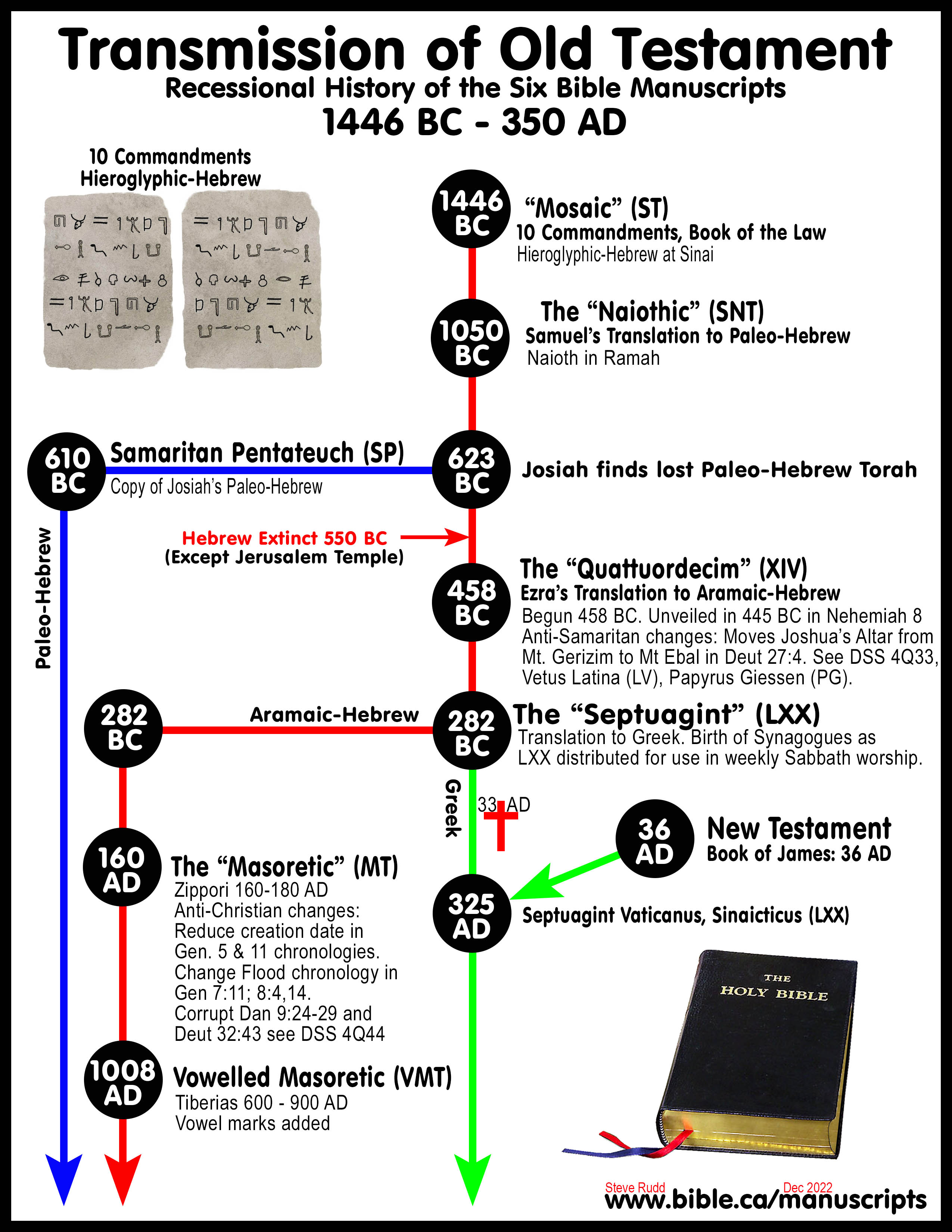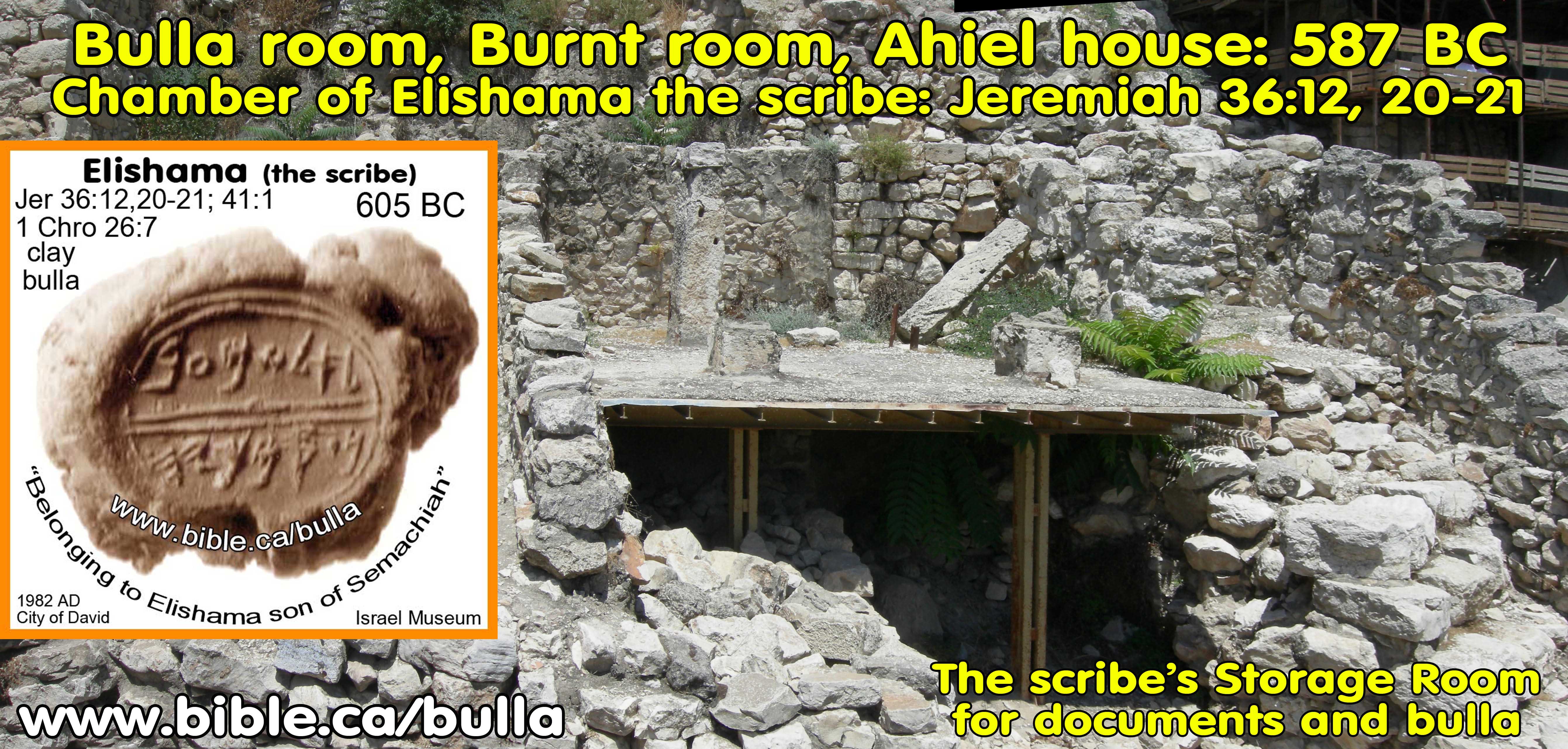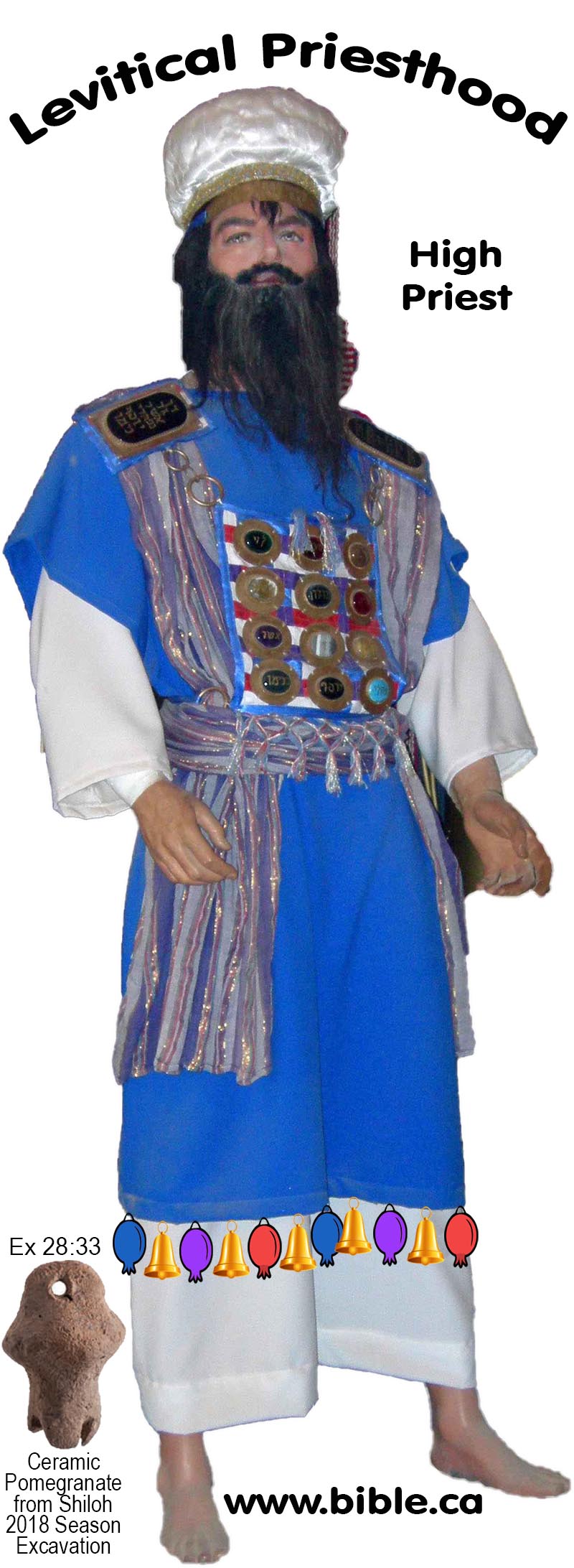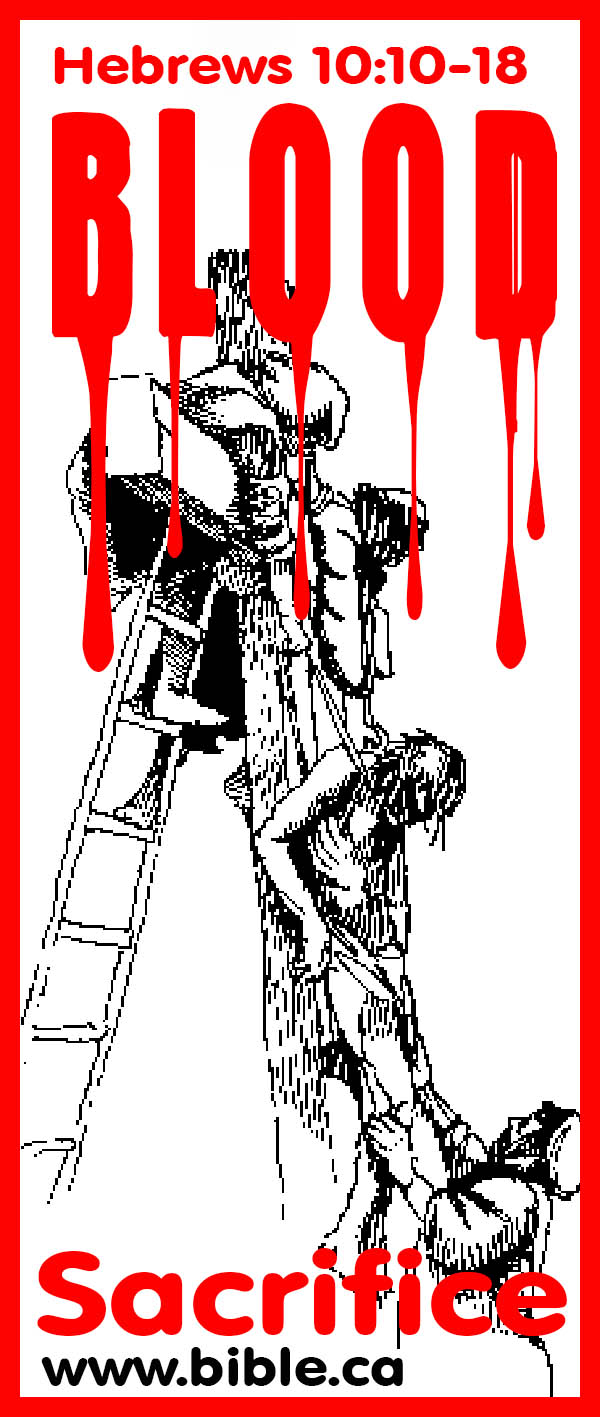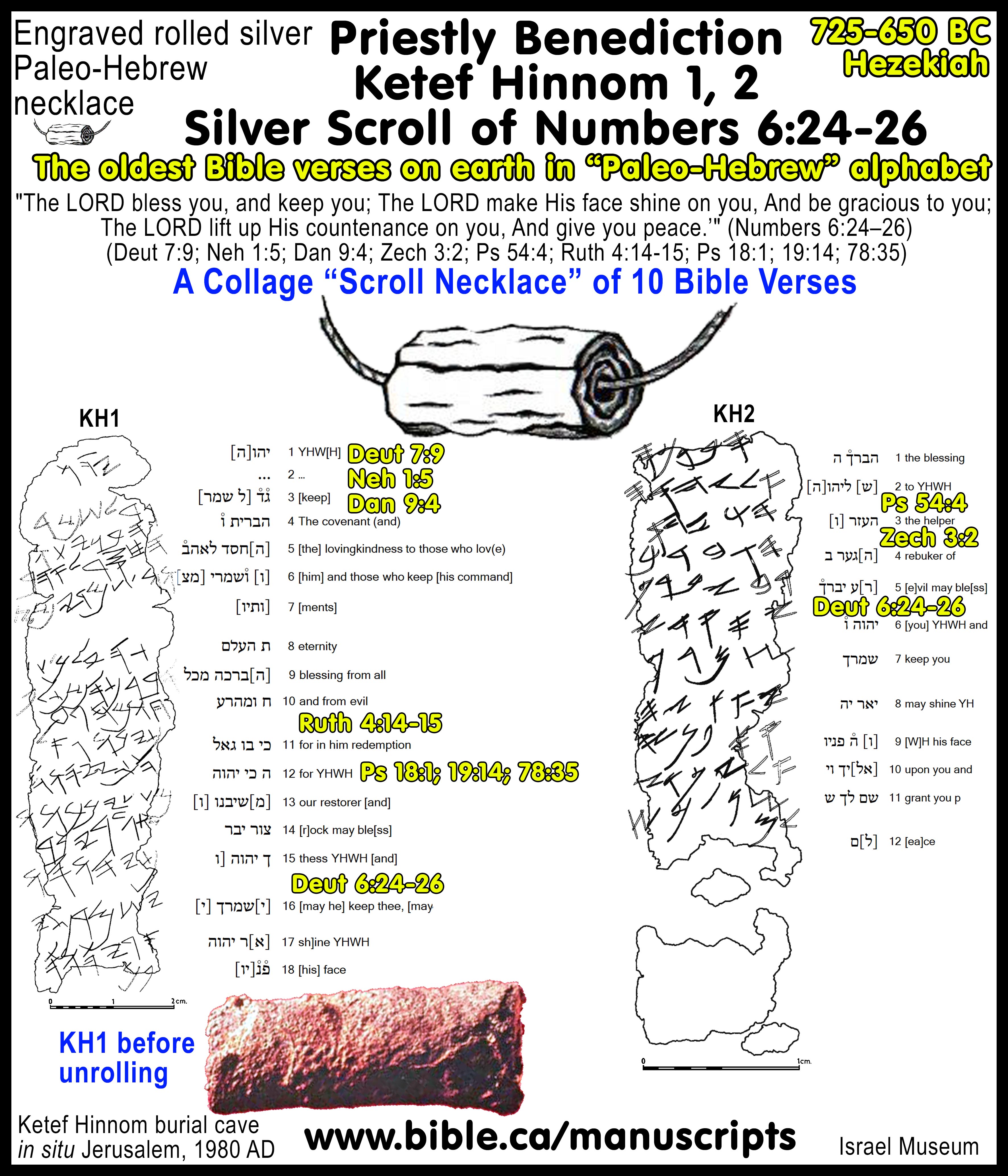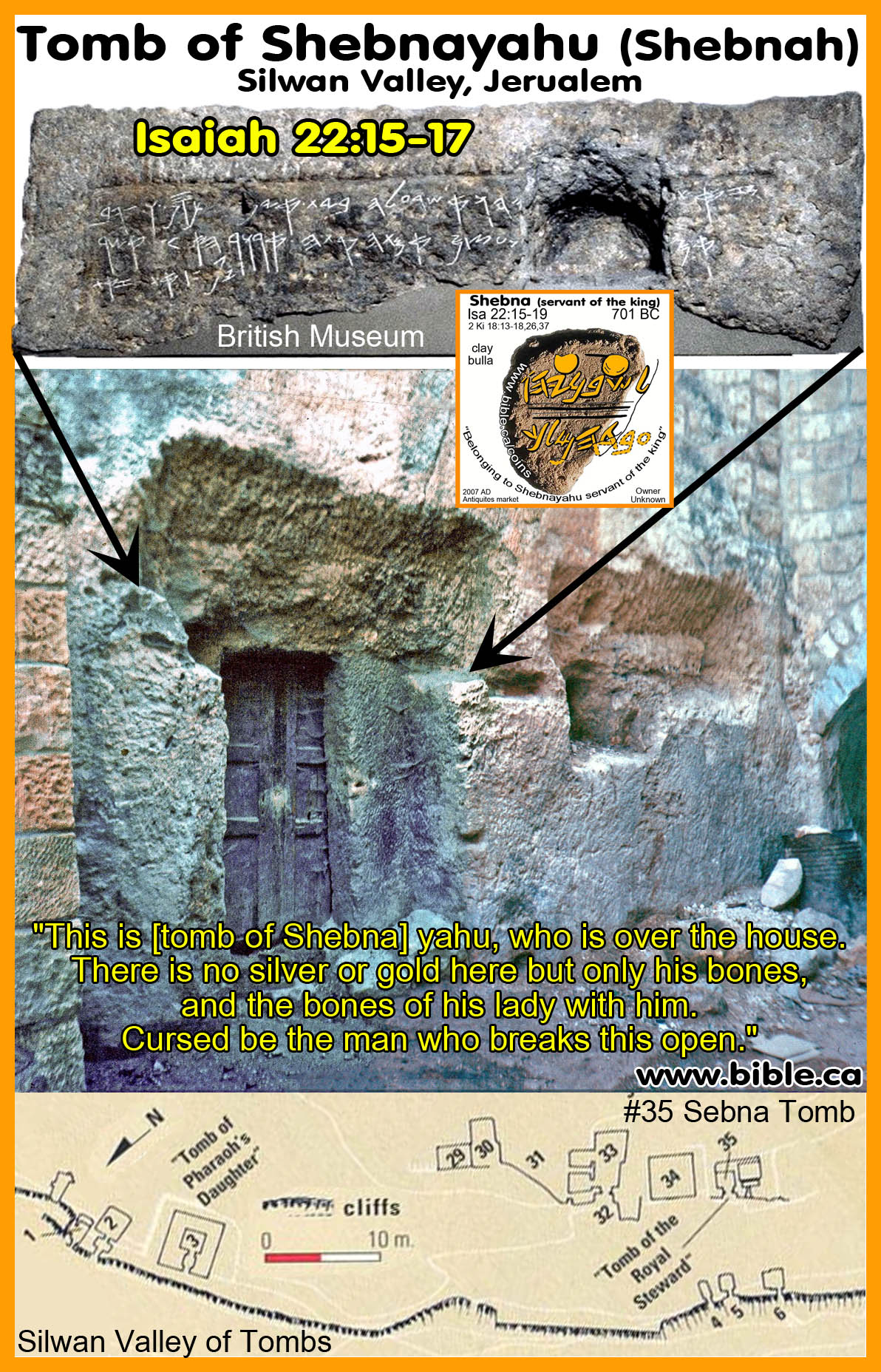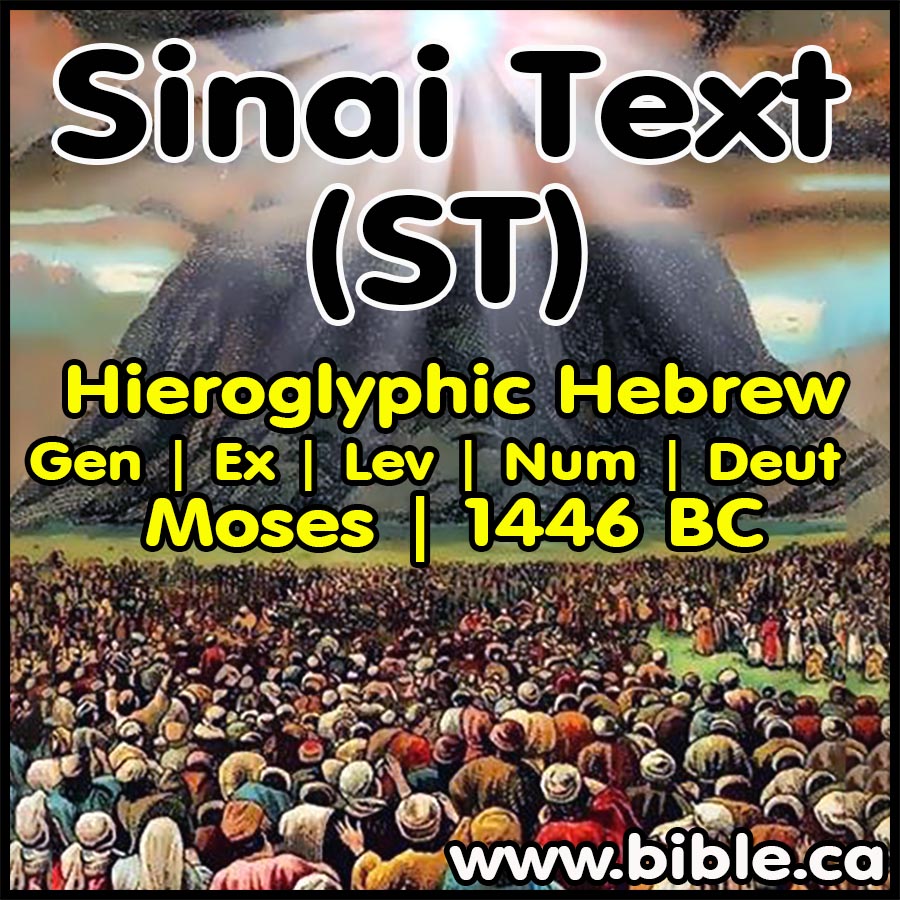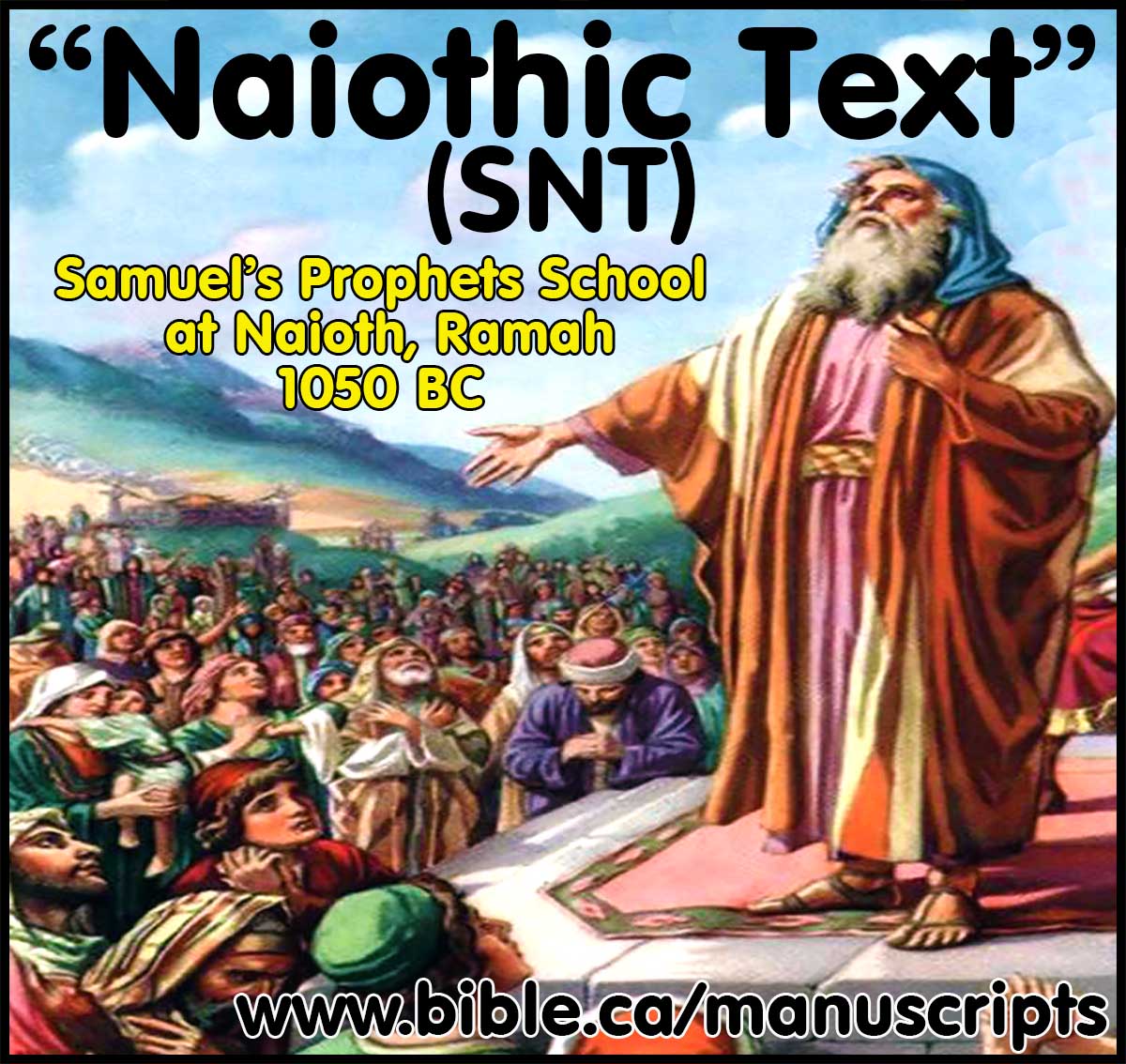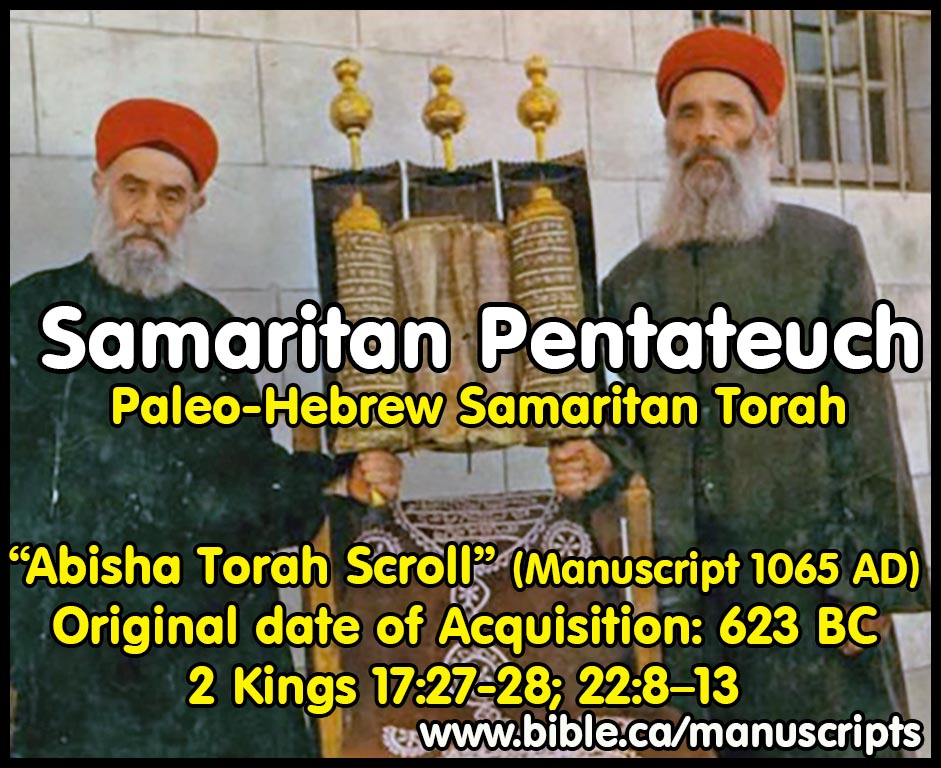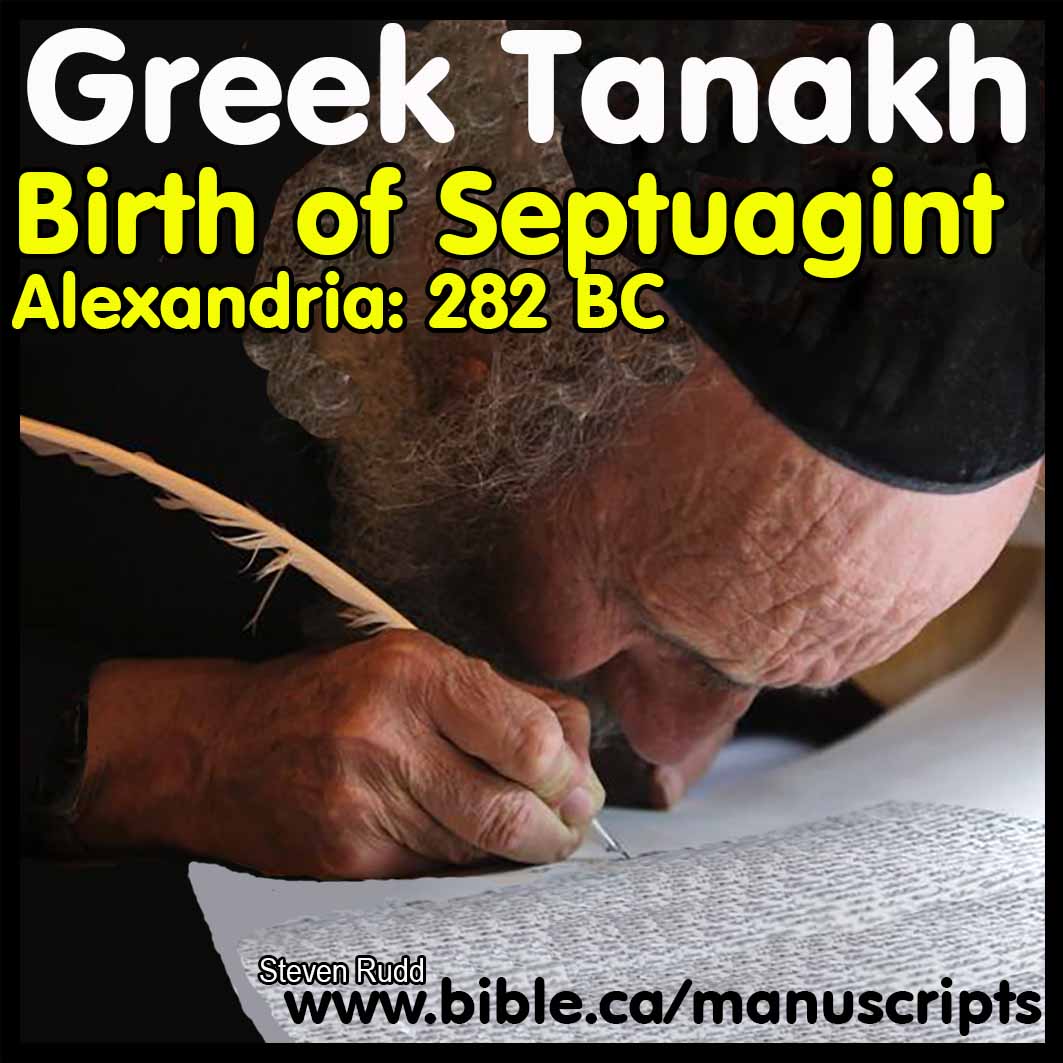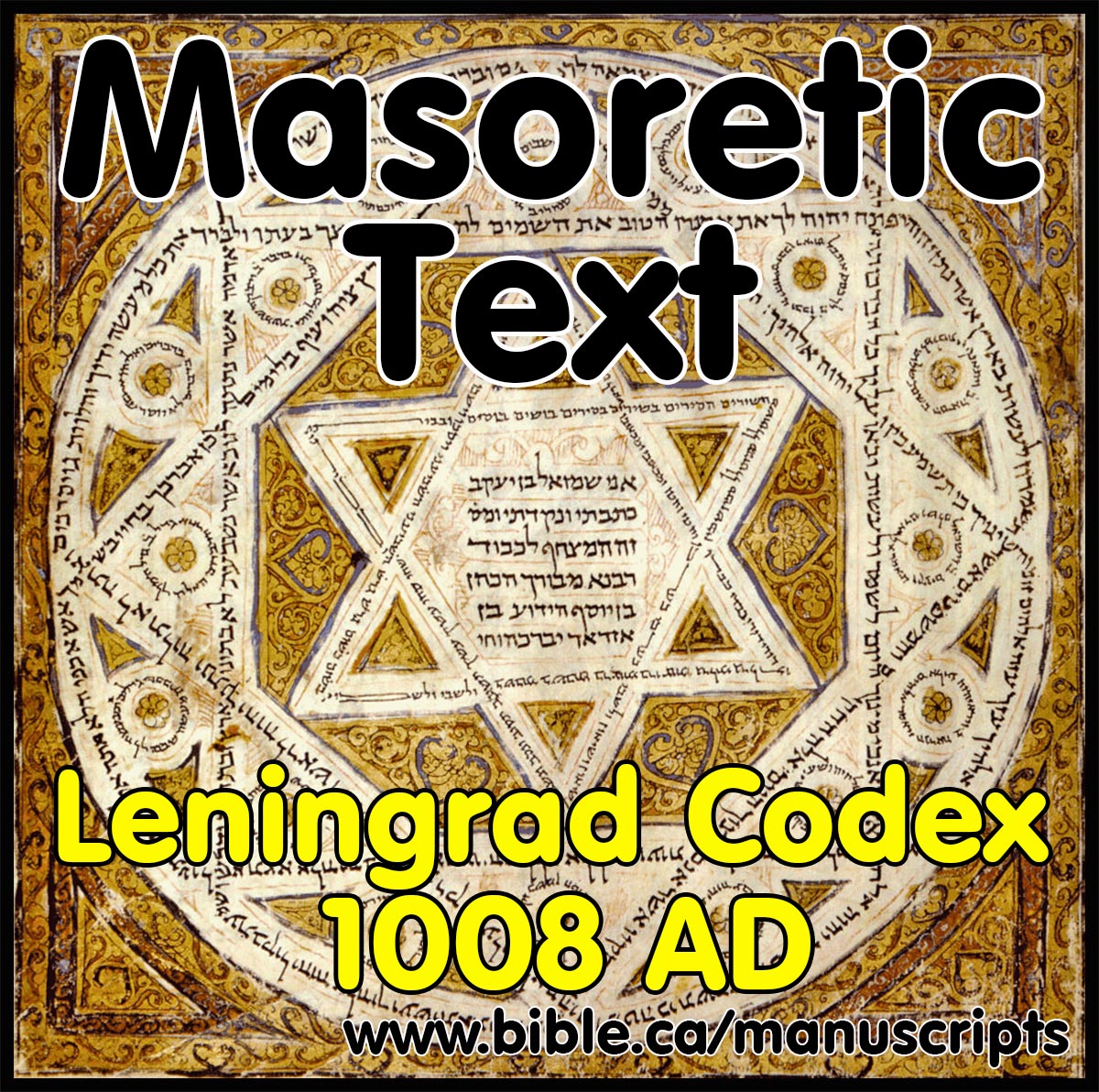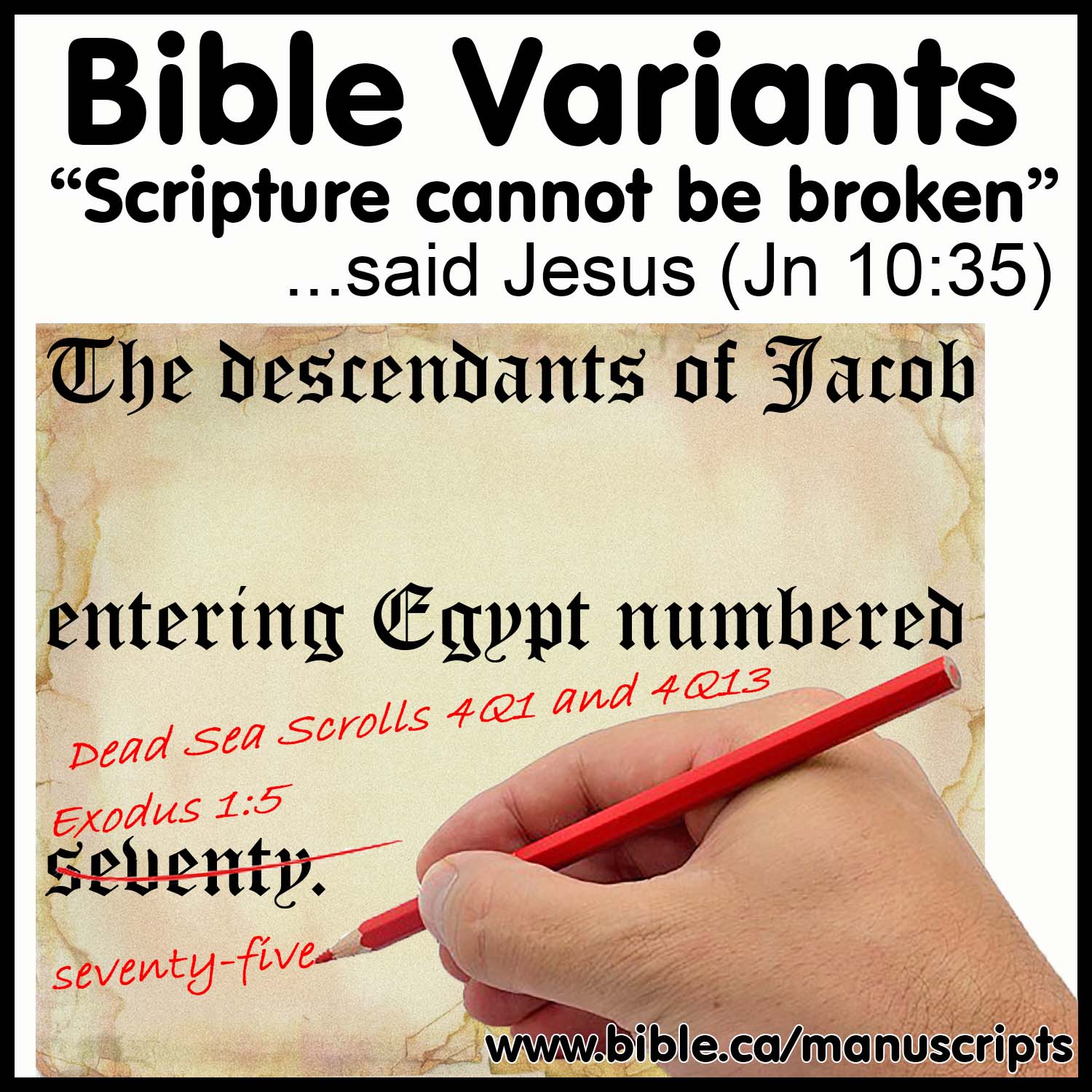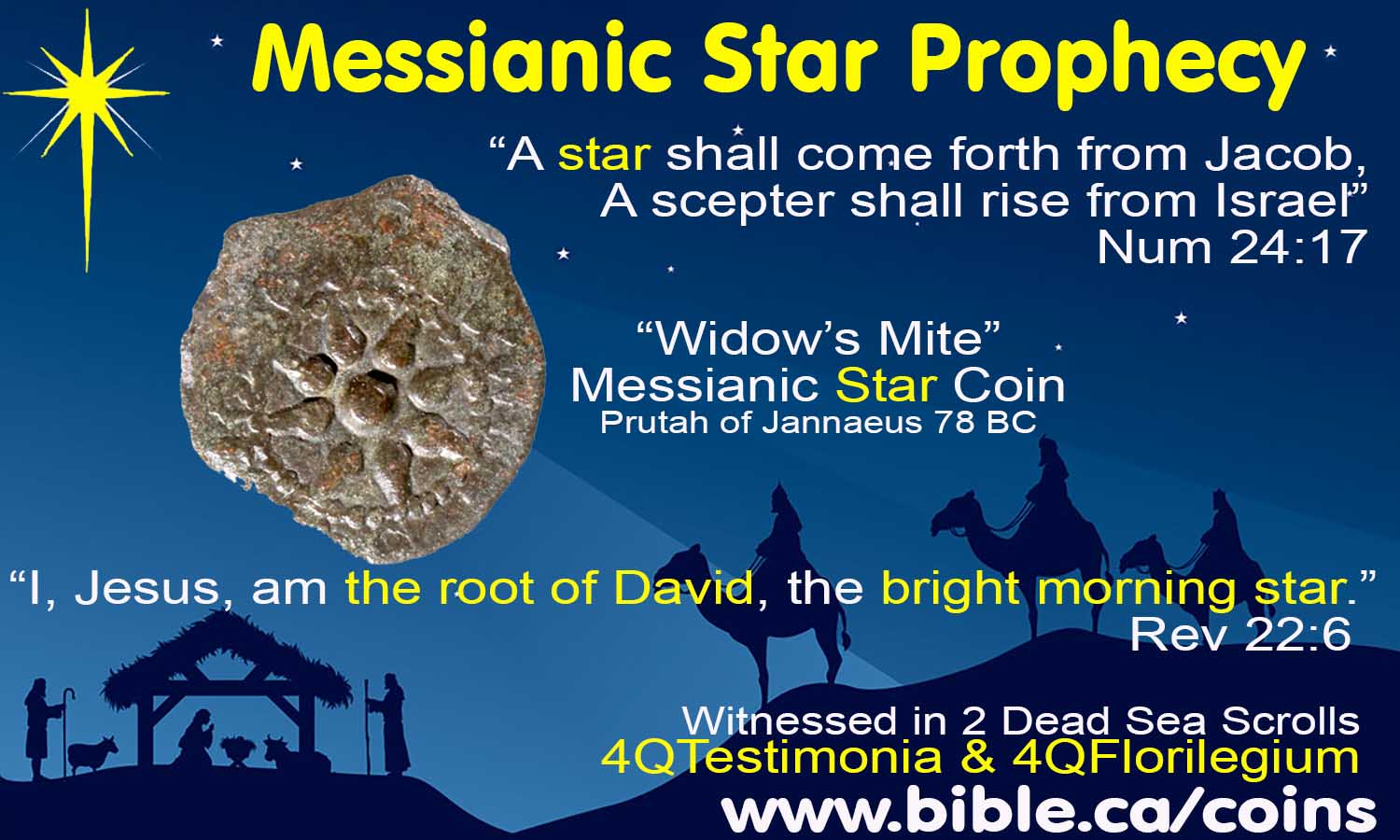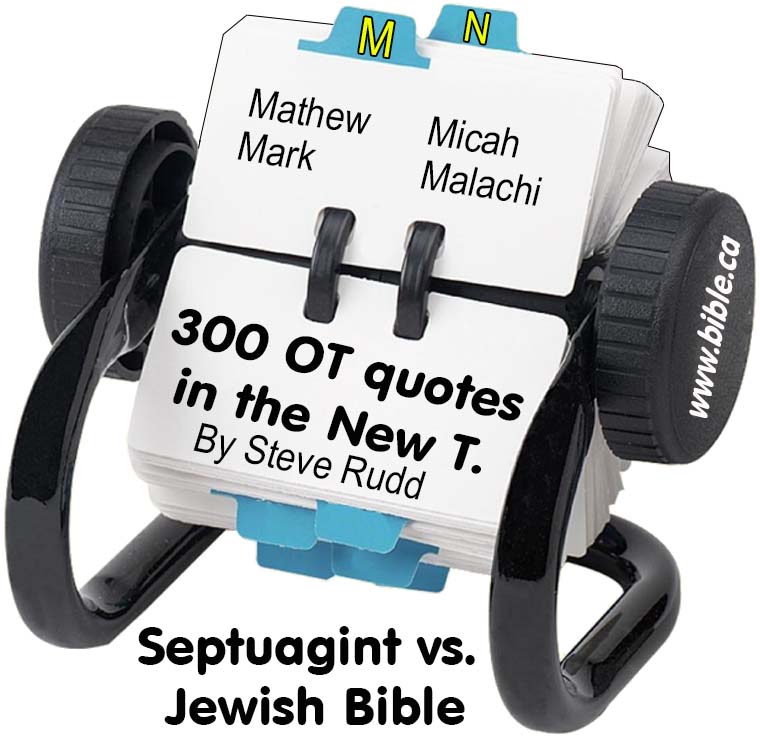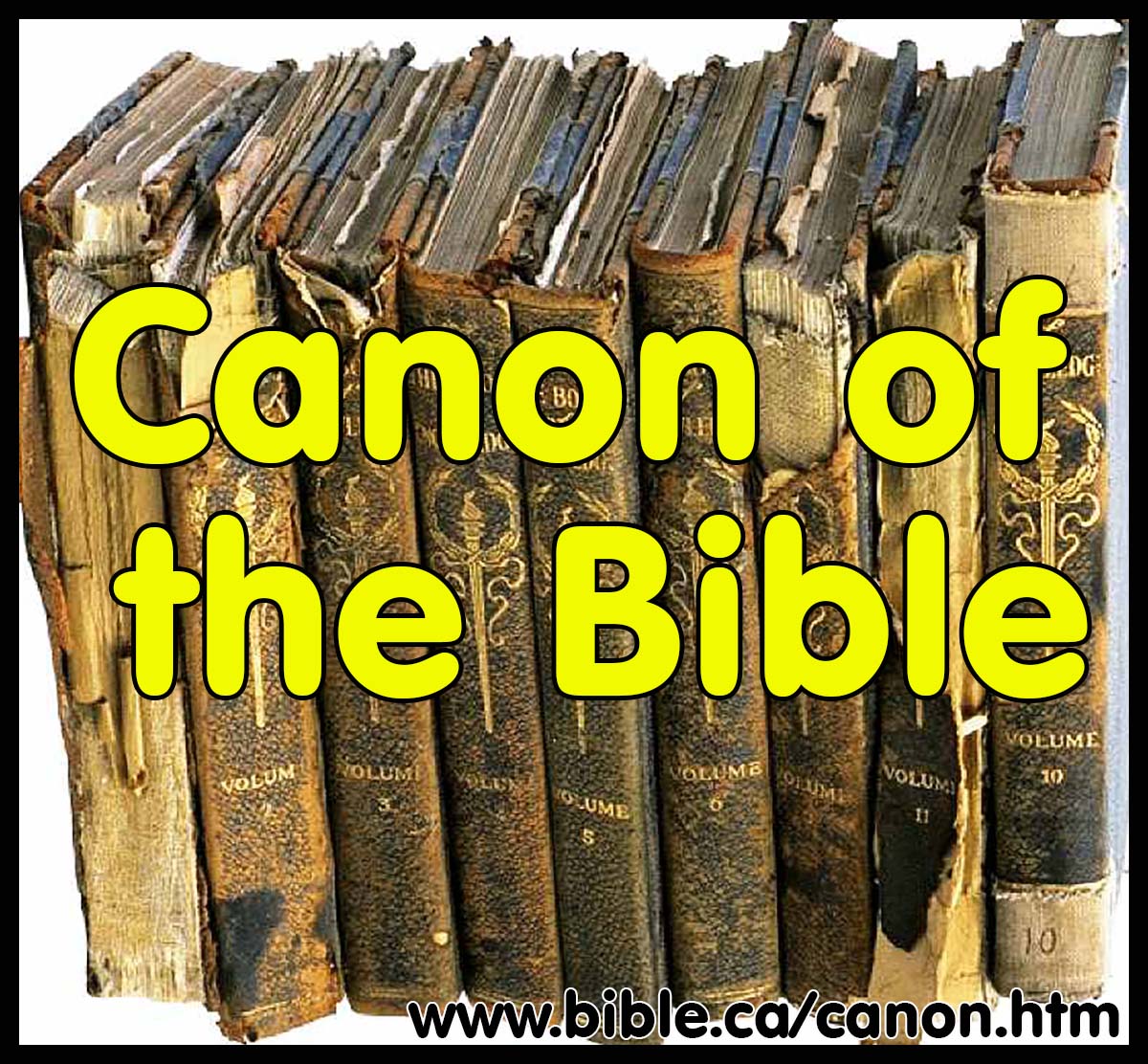|
Four Hebrew Bible Scripts 1. Mosaic-Hieroglyphic Hebrew script by invented by Joseph in 1859 BC. 2. Paleo-Hebrew script standardized by Samuel the prophet in 1050 BC 3. Aramaic-Hebrew “square” script adopted by Ezra the prophet in 458 BC. 4. Masoretic-Hebrew “vowelled” script invented by Masoretes in 600 AD. |
1859 BC: The birth of Hebrew writing
History of 4 Hebrew scripts and alphabets used by the Jews
The Greek Septuagint LXX
"Scripture cannot be broken" (Jesus, John 10:35)
Steve Rudd 2017
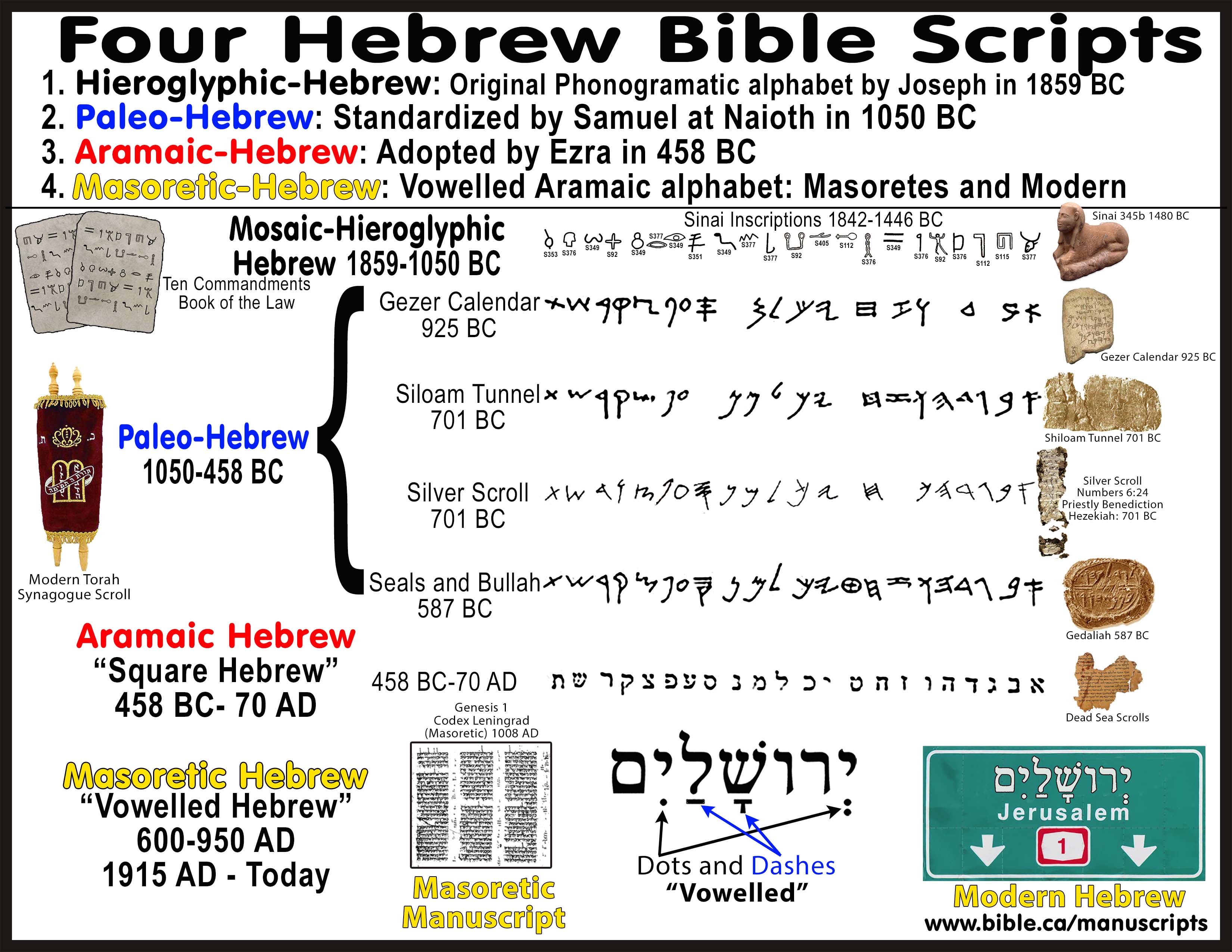
Abstract:
During the time of Abraham Hebrew was a spoken language with no writing script of any kind or alphabet. The first record of Hebrew script is the signet ring seal Judah gave Tamar as a pledge in Gen 38. Legal contracts at this time were based upon rituals like placing a hand on the genitals or taking a shoe off. The Hebrew people acquired a double bonus under Joseph, Ephraim and Manasseh by not only creating the first Hebrew writing, but also inventing the world’s first true alphabet. We know from the recently translated “Sinai inscriptions” that Joseph borrowed 22 Egyptian hieroglyphic symbols as the character alphabet for each sound in the Hebrew language. The alphabets of all other languages, including English use these same ancient symbols in spelling out of words. The Jews have used four different alphabets to spell out Hebrew words. The first is called “Hieroglyphic Hebrew” which was invented by Joseph and used by God in the Ten Commandments and Moses in the book of the Law that was placed on the side of the Ark of the Covenant. The shapes of each of the 22 letters become simplified over time down to the time of Samuel, who created the second script called “Paleo-Hebrew” in his Naioth preacher’s school. This second alphabet was used by David down to the Babylonian captivity when the diaspora Jews discarded their Nobel prize winning Paleo-Hebrew alphabet for their third script known as the “Aramaic Hebrew” alphabet. This is a bit confusing, but they continue to speak the Hebrew language, they simply swapped out, letter for letter, the Aramaic alphabet. It was the Hebrew language written in the foreign language alphabet of Aramaic. They spelled Hebrew words with Aramaic letters. The Germain speaking Jews of the middle ages did the same thing by swapping out the Germain alphabet for the Aramaic alphabet. Again, it was still Germain, they just spelled Germain words with the Aramaic alphabet and Yiddish was born. Yiddish is pure Germain spelled in the same Aramaic alphabet. Likewise the third Hebrew alphabet was pure Hebrew spelled in this same Aramaic alphabet. After Hebrew went extinct about 300 BC a fourth Hebrew alphabet was invented by the Masoretes in 600-900 AD that added vowels for the first time. This fourth Hebrew alphabet is known as “Masoretic Hebrew” and is used today in modern Israel starting in 1915 AD when the population mass converted from Germain language (Yiddish) to Hebrew. At the time of Jesus the branch/messiah, Hebrew was functionally extinct and the Jews in Judea spoke Aramaic language (not Hebrew) as their mother tongue but also spoke Greek as their universal language of commerce. The Jews outside Judea spoke Greek only. The only group using true Hebrew in the first century AD were the Jerusalem temple elites (high priest and Sadducees). Their public religious services were not understood by the masses the same way Catholic Latin mass in the USA is. The people watch the ritual but have no idea what the Jewish High priests are saying. With the birth of Synagogues in 280 BC, which used the Greek Tanakh (Septuagint), the heart of the masses moved to synagogue worship to meet their spiritual needs of worship. Just as first Hebrew alphabet prepared the way for the written law of Moses, so too the translating the 39 books of the Hebrew old testament into Greek prepared the way for the Church. At the birth of Christ, thousands of synagogues all over the world with their Greek Septuagint Old Testament and full immersion baptistries (Mikvaot) were fully prepared for conversion to Christianity. And convert to Jesus their messiah, they did!
Introduction:
1. Over the course of history, the Hebrew people have spoken many different languages.
|
Names |
Dates of use |
Language |
Alphabet |
|
Abrahamic Hebrew |
2275 BC-present |
Spoken Hebrew |
None |
|
Hieroglyphic Hebrew |
1859-1050 BC |
Hebrew |
Hebrew |
|
Paleo-Hebrew |
1050-458 BC |
Hebrew |
Hebrew |
|
Aramaic Syriac |
458 BC-200 AD |
Aramaic |
Aramaic |
|
Aramaic Hebrew "Square Hebrew" |
458 BC-200 AD |
Hebrew |
Aramaic |
|
Greek |
333 BC-200 AD |
Greek |
Greek |
|
Masoretic Hebrew "Vowelled Hebrew" Modern Jews |
600-1000 AD |
Hebrew |
Aramaic |
|
Yiddish |
900 AD-present |
German |
Aramaic |
2. History of the autograph script of the Old Testament (Tanakh):
a. Hieroglyphic Hebrew: 1446 BC: The two tablets of the Ten commandments, the Book of the Law on the side of the Ark. Torah (Gen – Deut) + book of Joshua (1100 BC)
b. Paleo-Hebrew: 1050-458 BC: book of Judges (720 BC), book of Kings/Chronicles (600 BC), poetry, prophets
c. Aramaic language and script: 550-450 BC: Parts of books of Daniel and Ezra.
3. History of Hebrew extant scripts and translations of the Old Testament (Tanakh):
a. We have no Bible text in the original Hieroglyphic Hebrew text
b. We have only one Bible verse (Num 6:24) in Paleo-Hebrew dating to 701 BC known as the “Silver Scroll”
c. We have portions of Bible books dating to c. 100 BC in Aramaic Hebrew. (Hebrew language using the Aramaic script)
d. The oldest complete copy of the Old Testament (Tanakh) in Hebrew is the Masoretic text dating to 1008 AD.
4. History of Greek extant scripts and translations of the Old Testament (Tanakh):
a. Ptolemy II oversaw the translation of the Torah (Gen – Deut) into Greek in 280 BC.
b. By 150 BC, the entire Tanakh (39 books of the Old testament) was fully translated into Greek.
c. We have two complete copies of the Greek Old Testament that dates from 325 AD.
5. Four Hebrew Scripts: We see therefore, that the Hebrews have had four different written alphabet scripts:
a. Mosaic-Hieroglyphic Hebrew: 1859-1050 BC
b. Paleo-Hebrew: 1050 – 458 BC
c. Aramaic Hebrew (Square Hebrew): 458 – 70 AD
d. Masoretic Hebrew (Vowelled, modern) 600-1000; 1915-present.
6. Date of Script changes and the person who made the changes:
e. Mosaic-Hieroglyphic Hebrew script by invented by Joseph in 1859 BC.
f. Paleo-Hebrew script standardized by Samuel in 1050 BC
g. Aramaic-Hebrew “square” script adopted by Ezra in 458 BC.
h. Masoretic-Hebrew “vowelled” script invented by Masoretes in 600 AD.
7. See full outline on Samuel’s and Ezra’s script changes in the bible manuscripts
I. Origin of the Hebrew Alphabet:
1. Hebrew as the first and oldest alphabet on earth: In order to understand the role the Greek Septuagint (LXX) played in the Old Testament (Tanakh), we must go to the time of Joseph in Egypt who invented the first alphabet on earth.
a.
See full outline “Hebrew
is the world’s first and oldest alphabet”
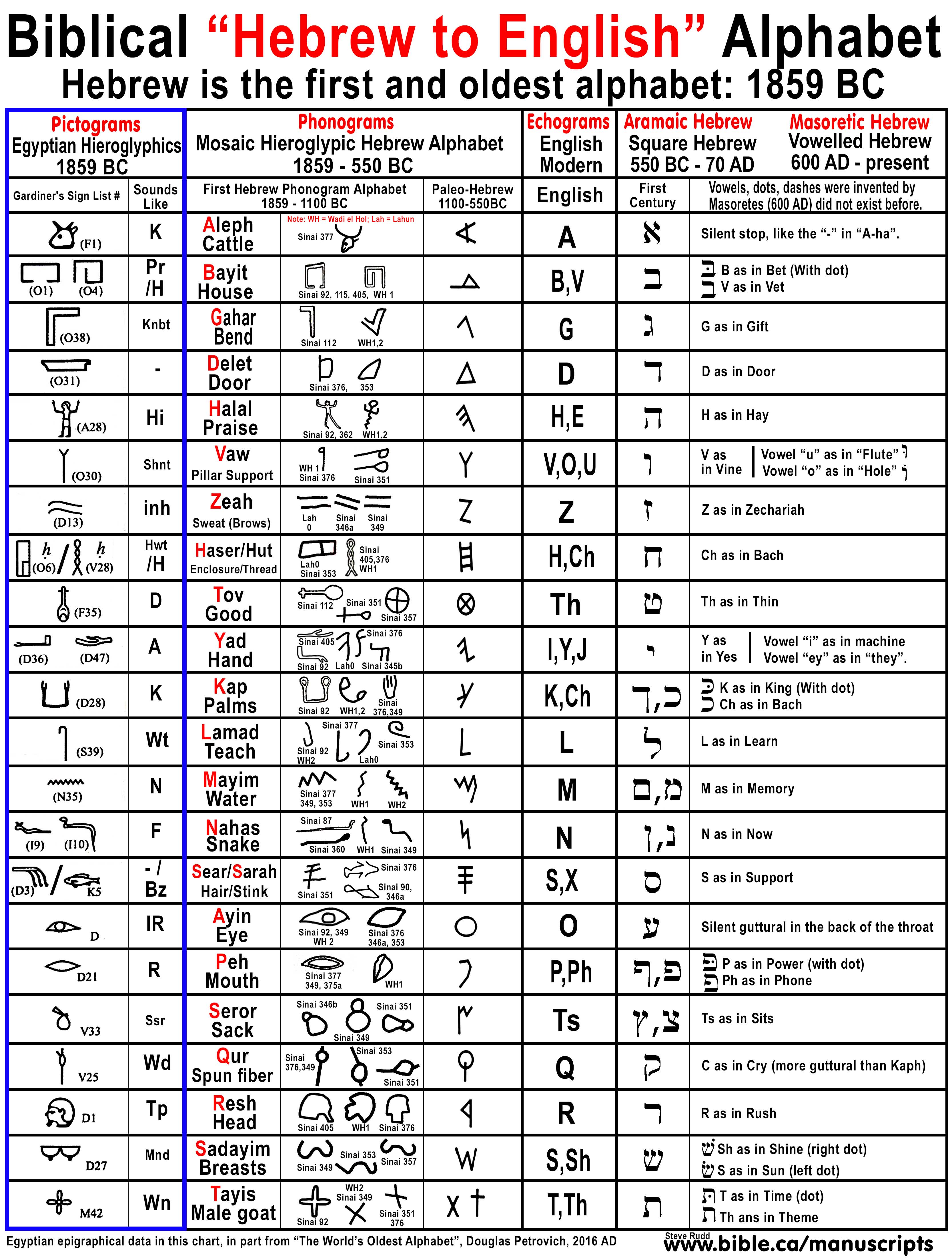
b. Before Jacob entered Egypt in 1876 BC the Hebrews used no written language. There is no evidence of any script during the patriarchal age.
c. In 1859 BC, Jacob died and Ephraim and Manasseh moved to Goshen (Avaris, Tel Dab’a)
d. Up to this point, the Hebrews had no written script but were “verbal only” much like the current Indians of North America (until Christian missionary James Evans created their first alphabet in 1827 AD in Canada).
e. Shortly after 1859 BC, Joseph, Ephraim and Manasseh created what we know today as “the world’s first and oldest alphabet” by selecting 22 of the 765 Egyptian hieroglyphic pictograms as a foundation of the written Hebrew language.
f.
While there were written languages that predated the
invention of the Hebrew alphabet, they used Sumerian cuneiform or Egyptian
hieroglyphs. Until then no cultures used an alphabet.
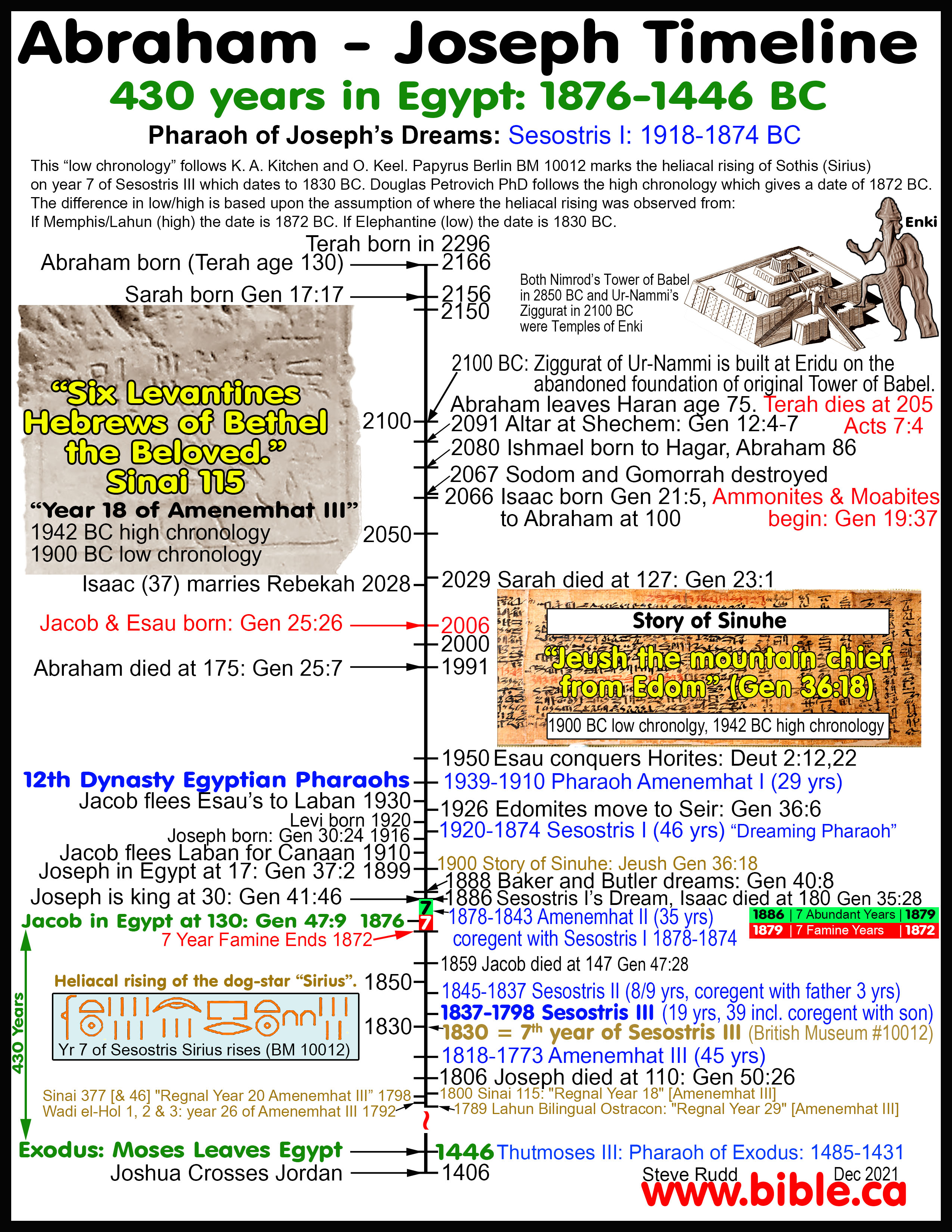
2. The Hebrew language has used four different alphabetic scripts:
a. Mosaic-Hieroglyphic Hebrew script: [Joseph, Moses, Deborah] 1859-1050 BC.
b. Paleo-Hebrew script: [Samuel to Zedekiah] 1050-458 BC.
c. Aramaic-Hebrew “square” script: [Daniel, Maccabees, Dead Sea Scrolls, Jesus] 458 BC -70 AD.
d. Masoretic-Hebrew “vowelled” script: [Masoretes, Modern Hebrew] 600-950 AD, 1915-present.
3. How old is the spoken Hebrew language?
a. While is makes perfect sense that Hebrew was the language of Adam and Eve in the garden of Eden and Noah on the Ark but this is pure speculation.
b. we can be sure that at least from the time of the tower of Babel (2275 BC)
II. Earliest Hebrew scripts: Signet rings:
(and possible archeological evidence)
|
Seal Ring of Hanon |
Bulla of Elishama the scribe |
A. Ritual covenants (not written): Abraham, Job, Jacob Boaz made covenants by engaging in a ritual rather than using written documents
1. In 2100 BC, Job lived at the same time as Abraham and used seals and bulla for security. Seals during this time did not seal written documents as in later times: “It is changed like clay under the seal; And they stand forth like a garment." (Job 38:14).
2. In 2091 BC, "God said to Abraham, “Bring Me a three year old heifer, and a three year old female goat, and a three year old ram, and a turtledove, and a young pigeon.” Then he brought all these to Him and cut them in two, and laid each half opposite the other; but he did not cut the birds. … It came about when the sun had set, that it was very dark, and behold, there appeared a smoking oven and a flaming torch which passed between these pieces. On that day the Lord made a covenant with Abram, saying, “To your descendants I have given this land." (Genesis 15:9-18)
3. Around 2028 BC Isaac marries Rebecca "Abraham said to his servant, the oldest of his household, who had charge of all that he owned, “Please place your hand under my thigh … So the servant placed his hand under the thigh of Abraham his master, and swore to him concerning this matter." (Genesis 24:2,9)
4. In 1859 BC Jacob dies "When the time for Israel to die drew near, he called his son Joseph and said to him, “Please, if I have found favor in your sight, place now your hand under my thigh and deal with me in kindness and faithfulness. Please do not bury me in Egypt," (Genesis 47:29)
5. In 1446 BC Law of Moses: “Then the elders of his city shall summon him and speak to him. And if he persists and says, ‘I do not desire to take her,’ then his brother’s wife shall come to him in the sight of the elders, and pull his sandal off his foot and spit in his face; and she shall declare, ‘Thus it is done to the man who does not build up his brother’s house.’ “In Israel his name shall be called, ‘The house of him whose sandal is removed.’" (Deuteronomy 25:8–10)
6. In 1283 BC Boaz marries Ruth "Now this was the custom in former times in Israel concerning the redemption and the exchange of land to confirm any matter: a man removed his sandal and gave it to another; and this was the manner of attestation in Israel. So the closest relative said to Boaz, “Buy it for yourself.” And he removed his sandal." (Ruth 4:7–8)
7.
In 600 BC: By the time of Jeremiah covenants were written on
papyrus then rolled up papyrus, tied with string, then sealed with a clay bulla
over the string knot for security.
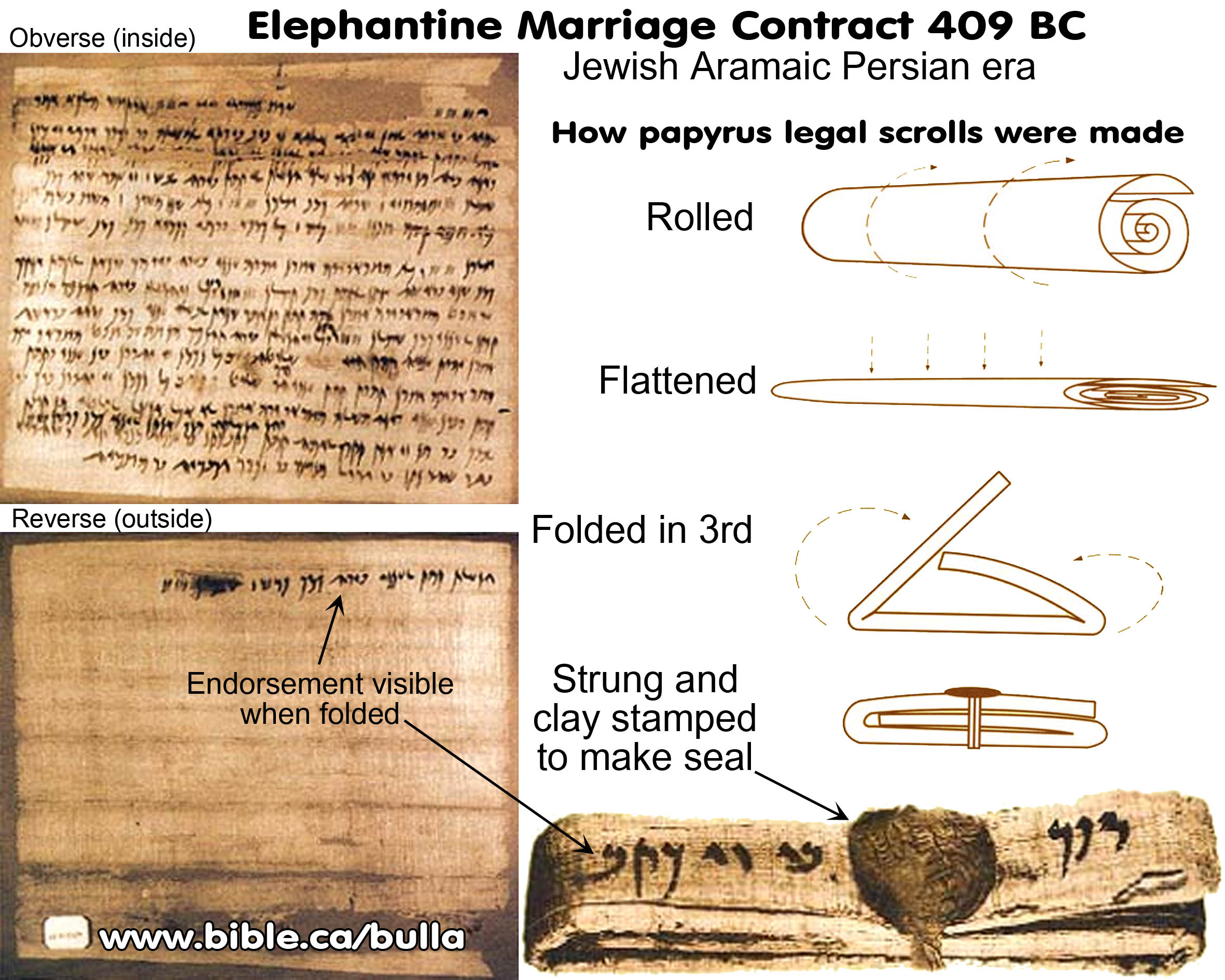
B. Signet rings (Seals) were engraved with finely scripted symbols on them to identify the owner.
1. See full outline on Seals and Bulla
a. Seal rings were pressed into clay to create a “bulla” as security seals and authorization of the ring owner.
b. Seal rings could be given to a servant which empowered him with the same authority and functioned as the owner.
c. Seal rings were used as tangible pledges of security.
2. 1899 BC at Timnah: (the year Joseph was sold into slavery)
a. This is before the first alphabet invented by Joseph after Jacob died.
b. This was either an Egyptian style name ring or a unique custom graphic of a lion etc.
c. Judah gave Tamar his signet ring as a pledge he would pay what he owed her.
d. "It was told to Tamar, “Behold, your father-in-law is going up to Timnah to shear his sheep.” So she removed her widow’s garments and covered herself with a veil, and wrapped herself, and sat in the gateway of Enaim, which is on the road to Timnah; for she saw that Shelah had grown up, and she had not been given to him as a wife. When Judah saw her, he thought she was a harlot, for she had covered her face. So he turned aside to her by the road, and said, “Here now, let me come in to you”; for he did not know that she was his daughter-in-law. And she said, “What will you give me, that you may come in to me?” He said, therefore, “I will send you a young goat from the flock.” She said, moreover, “Will you give a pledge until you send it?” He said, “What pledge shall I give you?” And she said, “YOUR SEAL and your cord, and your staff that is in your hand.” So he gave them to her and went in to her, and she conceived by him… It was while she was being brought out that she sent to her father-in-law, saying, “I am with child by the man to whom these things belong.” And she said, “Please examine and see, WHOSE SIGNET RING and cords and staff are these?” Judah recognized them, and said, “She is more righteous than I, inasmuch as I did not give her to my son Shelah.” And he did not have relations with her again." (Genesis 38:25-26)
3. 1886 BC: Joseph made King by Pharaoh (the year Isaac died)
a. The Seal ring of the 12 dynasty Egyptian pharaohs were scarabs/name rings made from Egyptian Hieroglyphics.
b. Pharaoh gave Joseph his signet ring to function as king of Egypt.
c. "Pharaoh said to Joseph, “See, I have set you over all the land of Egypt.” Then Pharaoh took off his signet ring from his hand and put it on Joseph’s hand, and clothed him in garments of fine linen and put the gold necklace around his neck. He had him ride in his second chariot; and they proclaimed before him, “Bow the knee!” And he set him over all the land of Egypt." (Genesis 41:41-43)
4. 1446 BC at Mt. Sinai: Gold signet rings melted and made into Hathor, the golden calf by Aaron
a. Each family had their own signet rings at the time of the Exodus.
b. These seal rings were most likely similar to other Hebrew seal impressions found in fired clay bulla from the time of Jeremiah and the destruction of Solomon’s temple in 587 BC.
c. "Everyone whose heart stirred him and everyone whose spirit moved him came and brought the Lord’s contribution for the work of the tent of meeting and for all its service and for the holy garments. Then all whose hearts moved them, both men and women, came and brought brooches and earrings and signet rings and bracelets, all articles of gold; so did every man who presented an offering of gold to the Lord." (Exodus 35:21–22)
5. 1446 BC at Mt. Sinai: Names of tribes engraved on clothing of Aaron the high priest:
|
The High priest had three different sets of engravings on his uniform
SEAL ON CROWN: “Holy to the Lord.” Exodus 39:30-31
TWO SHOULDER STONES: "names of the sons of Israel” Exodus 28:9-12
TWELVE STONES ON THE EPHOD BREASTPLATE: “names for the twelve tribes." (Exodus 39:8-14) |
a. The High Priest wore three sets of Seal stones that were engraved with Hebrew text indicating the twelve tribes were of God's family.
b. The script would have been “Mosaic-hieroglyphic Hebrew” also used by God to write the two tables of stone for the Ten commandments.
c. ONE STONE ON EACH SHOULDER: "You shall take two onyx stones and engrave on them the names of the sons of Israel, six of their names on the one stone and the names of the remaining six on the other stone, according to their birth. “As a jeweler engraves a signet, you shall engrave the two stones according to the names of the sons of Israel; you shall set them in filigree settings of gold. “You shall put the two stones on the shoulder pieces of the ephod, as stones of memorial for the sons of Israel, and Aaron shall bear their names before the Lord on his two shoulders for a memorial." (Exodus 28:9–12)
d. TWELVE STONES ON THE EPHOD BREASTPLATE: "He made the breastpiece, the work of a skillful workman, like the workmanship of the ephod: of gold and of blue and purple and scarlet material and fine twisted linen. It was square; they made the breastpiece folded double, a span long and a span wide when folded double. And they mounted four rows of stones on it. The first row was a row of ruby, topaz, and emerald; and the second row, a turquoise, a sapphire and a diamond; and the third row, a jacinth, an agate, and an amethyst; and the fourth row, a beryl, an onyx, and a jasper. They were set in gold filigree settings when they were mounted. The stones were corresponding to the names of the sons of Israel; they were twelve, corresponding to their names, engraved with the engravings of a signet, each with its name for the twelve tribes." (Exodus 39:8–14)
e. SEAL ON CROWN: "They made the plate of the holy crown of pure gold, and inscribed it like the engravings of a signet, “Holy to the Lord.” They fastened a blue cord to it, to fasten it on the turban above, just as the Lord had commanded Moses." (Exodus 39:30–31)
f.
This same combination of names of God’s people with
“Holy to the Lord” was used by the Holy Spirit to seal Christians in the new
Testament: See full
outline
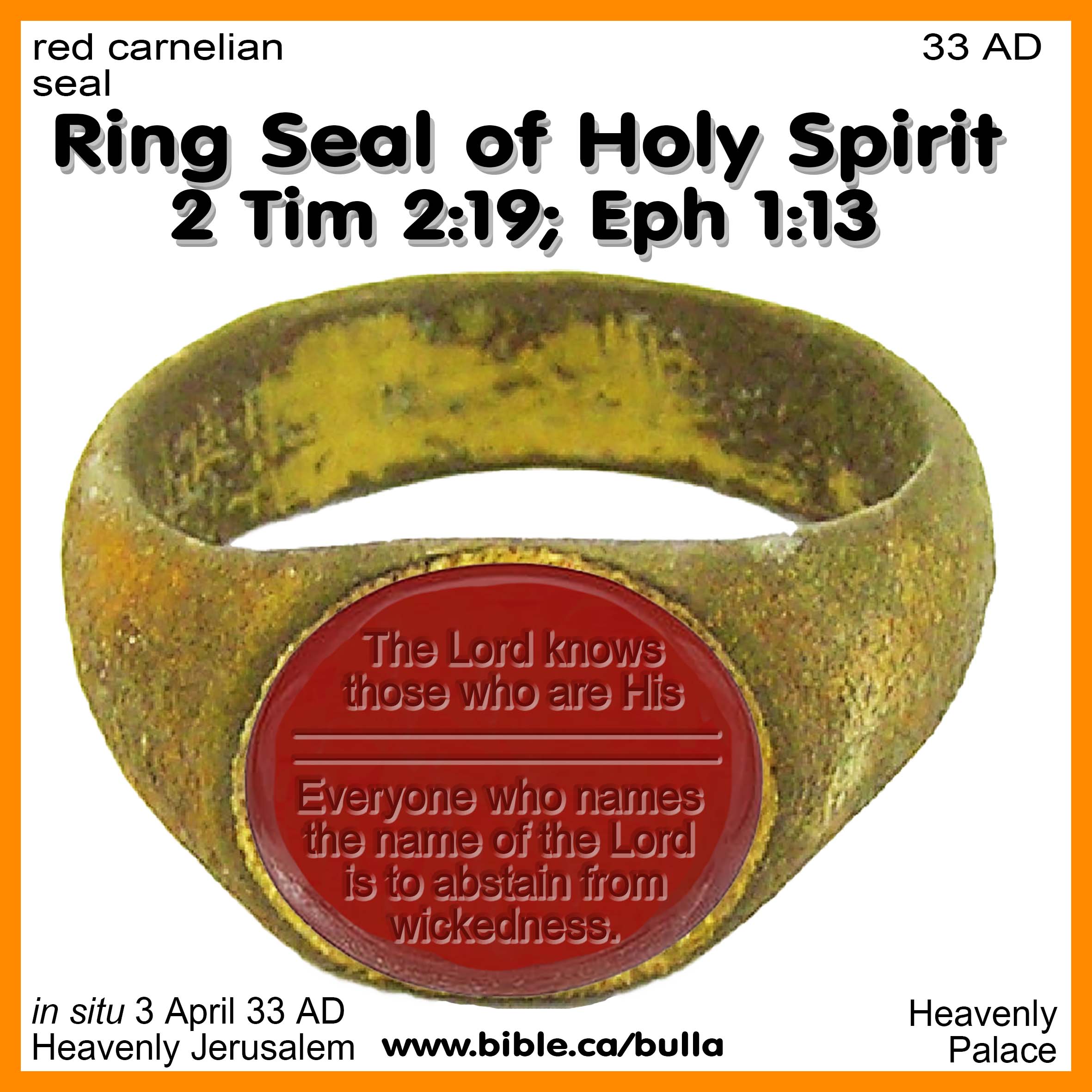
III. Four different Hebrew alphabet scripts:
The Hebrew language was spoken by Abraham in Ur of Chaldees until Hebrew went extinct as a common spoken language around 200 AD until it was revived in 1915 AD in modern Israel. During this period, the same Hebrew language has used four different alphabetic written scripts. The ten commandments inside the Ark of the covenant and the book of the law placed beside the Ark were written in 1446 BC in "Mosaic Hieroglyphic Hebrew" script which differs dramatically from Paleo-Hebrew in form. Most of the books of the Old Testament were written in “Paleo-Hebrew” script which was standardized by Samuel in 1050 BC. Paleo-Hebrew script was replaced by "Aramaic Hebrew" script in 458 BC by Ezra and continued to be used down to the time of Christ until Hebrew went extinct. “Masoretic Hebrew” script was invented by the Masoretes at Tiberias in 600 AD by adding vowels (dots and dashes) to the extinct first century "Aramaic Hebrew" script. The Masoretic manuscript (Codex Leningrad: 1008 AD) is the oldest extant complete copy of the Old Testament that underlies most modern Bibles today was written in "Masoretic Hebrew". Masoretic Hebrew became a dead language about 1000 AD. In 1915 AD a group of Jews in Tel Aviv revived "Masoretic Hebrew" and introduced it into schools so that by 1947 AD a sizable population spoke the Hebrew they still use today, which is the 4th Hebrew script.
A. HEBREW SCRIPT #1: "Mosaic Hieroglyphic Hebrew", consonantal Hebrew, (1956 – 1050 BC)
1. Joseph, Ephraim and Manasseh copied 22 of the 765 Egyptian hieroglyphic symbols and began to use these hieroglyphic symbols at the basis of the first alphabet.
a. See also: “Hebrew is the world’s first and oldest alphabet”
b. For the first time in history words were spelled out phonetically, sound by sound with 22 phonographic symbols.
c. The Hebrews selected 22 of the 734 Egyptian hieroglyphic symbols as their alphabet “character set”, one for each of the 22 phonic sounds in Hebrew.
d. Although each of the 22 Egyptian hieroglyphs had an Egyptian word associated with it, the Hebrews ignored this and assigned a corresponding Hebrew word to represent the hieroglyph.
e. The first letter of each word represented that sound in their alphabet (acrophony). For example, the Egyptian word for cow is KA but the Hebrew word for cow is ALEPH. The Egyptian hieroglyph for cattle was a cow head with horns and is pronounced “KA”, but the Hebrew word for cattle was “ALEPH”. Since the first letter/sound was “A”, the ox head became the symbol for the Hebrew letter A.
f. Hebrew is the “mother alphabet” from which all other alphabets, including English, are derived.
g. Hieroglyphic Hebrew was the “autograph” script that Moses used to write the original book of the Law that was placed on the side of the Ark of the covenant.
h. “Take this book of the law and place it beside the ark of the covenant of the Lord your God, that it may remain there as a witness against you." (Deuteronomy 31:26)
2. No Bible manuscripts in Mosaic-Hieroglyphic script:
a. The only examples we have of this script is from the 16 Sinai inscriptions
3.
Ten commandments written by God in Hieroglyphic Hebrew on two stone
tablets. Below is what the Ten commandments looked like in the Hieroglyphic
alphabet letters:
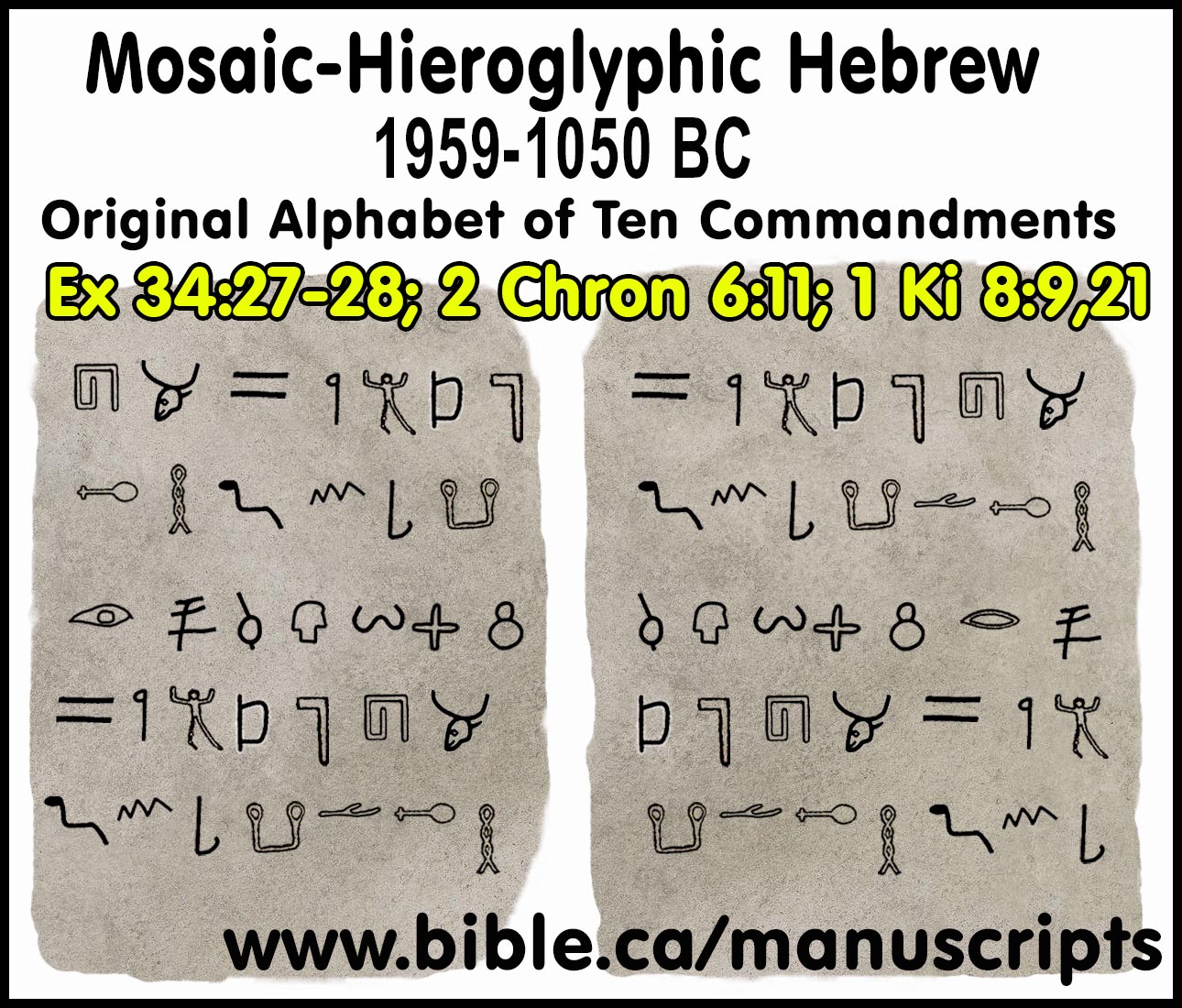
4. In 1446 BC at Mt. Sinai God wrote the text of the Ten commandments with His finger:
a. "When He had finished speaking with him upon Mount Sinai, He gave Moses the two tablets of the testimony, tablets of stone, written by the finger of God." (Exodus 31:18)
b. "Then Moses turned and went down from the mountain with the two tablets of the testimony in his hand, tablets which were written on both sides; they were written on one side and the other. The tablets were God’s work, and the writing was God’s writing engraved on the tablets." (Exodus 32:15–16)
c. "Now the Lord said to Moses, “Cut out for yourself two stone tablets like the former ones, and I will write on the tablets the words that were on the former tablets which you shattered." (Exodus 34:1)
5. The Ten Commandments were the text of the Old/first covenant and were placed inside the Ark of the Covenant:
a. 2 Chronicles 6:11: "And there I have set the ark, in which is the covenant of the Lord, which He made with the sons of Israel."
b. 1 Kings 8:9,21: V9 There was nothing in the ark except the two tablets of stone which Moses put there at Horeb, where the Lord made a covenant with the sons of Israel, when they came out of the land of Egypt." ... V21 "And there I have set a place for the ark, in which is the covenant of the Lord, which He made with our fathers when He brought them from the land of Egypt."
c. "Then the Lord said to Moses, “Write down these words, for in accordance with these words I have made a covenant with you and with Israel.” So he was there with the Lord forty days and forty nights; he did not eat bread or drink water. And he wrote on the tablets the words of the covenant, the Ten Commandments." (Exodus 34:27–28)
6. Christians do not keep the Ten commandments because they are an abolished code of law:
|
Christ nailed the 10 commandments to the cross: |
|
|
"Having canceled out the certificate of debt consisting of decrees against us, which was hostile to us; and He has taken it out of the way, having nailed it to the cross." (Colossians 2:14) |
|
a. The Ten commandments were the physical object of the old covenant which was abolished and replaced by the Law of Christ.
b. "“Behold, days are coming,” declares the Lord, “when I will make a new covenant with the house of Israel and with the house of Judah, not like the covenant which I made with their fathers in the day I took them by the hand to bring them out of the land of Egypt, My covenant which they broke, although I was a husband to them,” declares the Lord." (Jeremiah 31:31–32)
c. "But now He has obtained a more excellent ministry, by as much as He is also the mediator of a better covenant, which has been enacted on better promises. For if that first covenant had been faultless, there would have been no occasion sought for a second." (Hebrews 8:6–7)
d. "When He said, “A new covenant,” He has made the first obsolete. But whatever is becoming obsolete and growing old is ready to disappear. Now even the first covenant had regulations of divine worship and the earthly sanctuary. For there was a tabernacle prepared, the outer one, in which were the lampstand and the table and the sacred bread; this is called the holy place. Behind the second veil there was a tabernacle which is called the Holy of Holies, having a golden altar of incense and the ark of the covenant covered on all sides with gold, in which was a golden jar holding the manna, and Aaron’s rod which budded, and the tables of the covenant" (Hebrews 8:13-9:4)
7. The Book of the Law was placed beside the Ark of the Covenant:
a. In 1446 BC, the Ark of the Covenant housed the Ten Commandments (inside) and the book of the law (on the side)
b. Both the Decalogue and the book of the law were written in Mosaic
Hieroglyphic Script
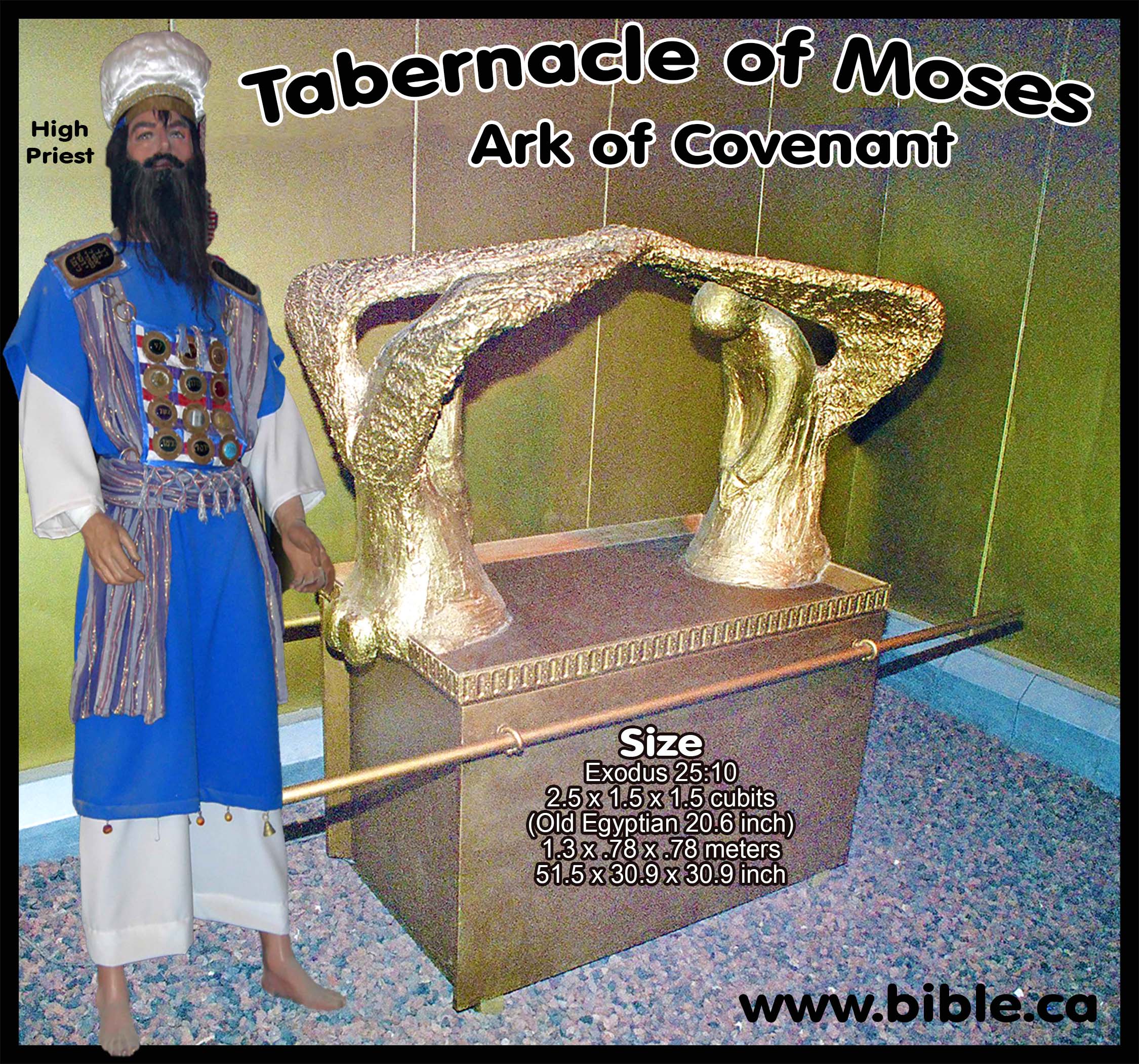
B. HEBREW SCRIPT #2: "Paleo-Hebrew", Post-Shiloh (1050-458 BC)
1. Samuel standardized the Paleo-Hebrew script at his Naioth, his prophet’s training school at Ramah around 1050 BC
a. See also Samuel’s Translation of Bible manuscripts into Paleo-Hebrew at Ramah in 1050 BC
2. "Paleo-Hebrew" is a simplification of the Hieroglyphic Hebrew text from which it had its origin.
a. Individual alphabet letters became standardized under the new Paleo-Hebrew script around the time of King David.
b. It was faster and easier to use than Hieroglyphic Hebrew with identical sounds for each of the 22 letters of the alphabet.
3. It was Samuel, in his “prophets school” called “Naioth” who standardized the Paleo-Hebrew text, paving the way for the King David and Solomon.
a. Paleo-Hebrew was used after the destruction of Shiloh in 1094 BC down to King Zedekiah in 587 BC.
b. Paleo-Hebrew, therefore was to David and Solomon what the Septuagint was to the New Testament church.
i. Naioth is referenced 6 times:
8. ii. "Now David fled and escaped and came to Samuel at Ramah, and told him all that Saul had done to him. And he and Samuel went and stayed in Naioth. It was told Saul, saying, “Behold, David is at Naioth in Ramah.” Then Saul sent messengers to take David, but when they saw the company of the prophets prophesying, with Samuel standing and presiding over them, the Spirit of God came upon the messengers of Saul; and they also prophesied. When it was told Saul, he sent other messengers, and they also prophesied. So Saul sent messengers again the third time, and they also prophesied. Then he himself went to Ramah and came as far as the large well that is in Secu; and he asked and said, “Where are Samuel and David?” And someone said, “Behold, they are at Naioth in Ramah.” He proceeded there to Naioth in Ramah; and the Spirit of God came upon him also, so that he went along prophesying continually until he came to Naioth in Ramah. He also stripped off his clothes, and he too prophesied before Samuel and lay down naked all that day and all that night. Therefore they say, “Is Saul also among the prophets?” Then David fled from Naioth in Ramah, and came and said to Jonathan, “What have I done? What is my iniquity? And what is my sin before your father, that he is seeking my life?”" (1 Samuel 19:18–20:1)
c. It makes perfect sense for Samuel to have invented Paleo-Hebrew, since he ran a formal school for the Hebrew prophets.
d. Naioth as the genesis of Paleo-Hebrew is also a perfect match the archeologic inscriptional data that we have found.
e. After the destruction of Solomon's temple in 587 BC the "Paleo-Hebrew" alphabet script soon became extinct among the Jewish public.
f. While in captivity and around 550 BC, Paleo-Hebrew script was replaced by Aramaic script for the same spoken Hebrew language.
4. Signing your name with an X only works in Mosaic Hebrew not Aramaic in Ezekiel 9:4-6; Job 31:35:
a. Only in the Paleo-Hebrew alphabet is this possible because the corresponding letter in Aramaic is not a cross symbol "+". (check alphabet chart above)
b. This is the origin of signing your name with an X. The original was a cross + but like most of the Hebrew alphabet letters, they were rotated 90 degrees so the ancient tradition of signing with a cross "+" became signing with an "X" we are familiar with today.
c. "The Lord said to him, “Go through the midst of the city, even through the midst of Jerusalem, and put a mark [tav, cross symbol +] on the foreheads of the men who sigh and groan over all the abominations which are being committed in its midst.” But to the others He said in my hearing, “Go through the city after him and strike; do not let your eye have pity and do not spare. “Utterly slay old men, young men, maidens, little children, and women, but do not touch any man on whom is the mark [tav, cross symbol +]; and you shall start from My sanctuary.” So they started with the elders who were before the temple." (Ezekiel 9:4–6)
d. "Oh that I had one to hear me! Behold, here is my signature [tav, cross symbol +]; Let the Almighty answer me! And the indictment which my adversary has written," (Job 31:35)
e. In Ezekiel 9:4,6 and Job 31:35 a "+" (tav = last letter of alphabet) is used for Job's signature and marking the righteous during the time of Zedekiah. The corresponding letter in Aramaic is not an "+".
5. We have no extant manuscripts of the Old Testament written in "Paleo-Hebrew".
a. Most of the Old Testament was written in Paleo-Hebrew (after 1100 BC, including the first five books of “Moses”)
b. All copies have been lost of these original autograph manuscripts of the bible in Paleo-Hebrew.
c. The only archeological remnant of "Paleo-Hebrew" is the Silver Scroll written in 701 BC (the time of Hezekiah) that quotes Numbers 6:24-26 identical to how it reads in our Bibles today. "The Lord bless you, and keep you; The Lord make His face shine on you, And be gracious to you; The Lord lift up His countenance on you, And give you peace.’"
d. This proves that the text of the bible has not changed over 2700 years!
6. THE TWO SILVER SCROLLS: The oldest "Paleo-Hebrew" text of the Bible discovered so far:
a. The Silver Scrolls are known as "Ketef Hinnom” #1, #2" (KH1, KH2) and are a collage of 11 different Bible verses including the Numbers 6 "Priestly benediction" text.
b. The scrolls were worn around the neck as necklaces and were found in situ in a Ketef Hinnom burial cave in Jerusalem in 1980 AD in a professional three dimensional archeological excavation.
c. The two scrolls are the prize of the Israel Museum in Jerusalem and on permanent display.
d. The scroll references a collage of 10 different Bible verses (Deut 5:24-26; 7:9; Neh 1:5; Dan 9:4; Zechariah 3:2; Ps 54:4; Ruth 4:14-15; Ps 18:1; 19:14; 78:35).
i. “You said, ‘Behold, the LORD our God has shown us His glory and His greatness, and we have heard His voice from the midst of the fire; we have seen today that God speaks with man, yet he lives. ‘Now then why should we die? For this great fire will consume us; if we hear the voice of the LORD our God any longer, then we will die. ‘For who is there of all flesh who has heard the voice of the living God speaking from the midst of the fire, as we have, and lived?" (Deuteronomy 5:24–26)
ii. "“Know therefore that the LORD your God, He is God, the faithful God, who keeps His covenant and His lovingkindness to a thousandth generation with those who love Him and keep His commandments;" (Deuteronomy 7:9)
iii. "I said, “I beseech You, O LORD God of heaven, the great and awesome God, who preserves the covenant and lovingkindness for those who love Him and keep His commandments," (Nehemiah 1:5)
iv. "I prayed to the LORD my God and confessed and said, “Alas, O Lord, the great and awesome God, who keeps His covenant and lovingkindness for those who love Him and keep His commandments," (Daniel 9:4)
v. "The LORD said to Satan, “The LORD rebuke you, Satan! Indeed, the LORD who has chosen Jerusalem rebuke you! Is this not a brand plucked from the fire?”" (Zechariah 3:2)
vi. "Behold, God is my helper; The Lord is the sustainer of my soul." (Psalm 54:4)
vii. "Then the women said to Naomi, “Blessed is the LORD who has not left you without a redeemer today, and may his name become famous in Israel. “May he also be to you a restorer of life and a sustainer of your old age; for your daughter-in-law, who loves you and is better to you than seven sons, has given birth to him.”" (Ruth 4:14–15)
viii. "“I love You, O LORD, my strength.”" (Psalm 18:1)
ix. "Let the words of my mouth and the meditation of my heart Be acceptable in Your sight, O LORD, my rock and my Redeemer." (Psalm 19:14)
x. "And they remembered that God was their rock, And the Most High God their Redeemer." (Psalm 78:35)
e. The silver scroll is important because it proves that our Bible is unchanged from the time of 700 BC to 1000 AD.
C. HEBREW SCRIPT #3: "Aramaic Hebrew", Square Hebrew, consonantal Hebrew (550 - 70 AD)
1. Ezra translated the Bible manuscripts from Paleo-Hebrew into Aramaic Hebrew in 458 BC.
a. See also: Ezra’s Translation of Bible manuscripts from Paleo-Hebrew into Aramaic-Hebrew in 458 BC
2. In the simplest terms "Aramaic Hebrew" is the spoken Hebrew language using the Aramaic alphabet.
a. Aramaic Hebrew is the Hebrew language not the Aramaic language.
b. Aramaic Hebrew is the spoken Hebrew language that uses an alternate alphabet (Aramaic alphabet)
c. Aramaic Hebrew exchanged/substituted the Paleo-Hebrew alphabet characters for that of a foreign language (Aramaic).
3. Aramaic is a sister Semitic language to Hebrew that dates back to 900 BC and was the universal official language of the Assyrians (700 BC) and Babylonians (600 BC) the same way English is today throughout the world. When the Jews entered Babylonian during the captivity of 605-536 BC, they started speaking a new language called Aramaic. Since Aramaic and Hebrew are sister languages like Spanish and French, they replaced the Paleo-Hebrew alphabet of Samuel, with the Aramaic alphabet. It was during the Babylonian captivity (605-536 BC) and Persian empire, Aramaic became the working language of Jews in both worship and the marketplace until the advent of the Greek Kingdom.
4. Aramaic was spoken by Hebrew leaders but not the common people in 701 BC: Isa 36:11; 2 Kings 18:26
a. Eliakim, Shebna and Joah were Hebrew servants of Hezekiah who spoke Aramaic AND Hebrew.
b. The common people DID NOT speak Aramaic, but Hebrew only.
c. Rabshakeh, the servant of Sennacherib, is also bilingual in both Aramaic and Hebrew. He “trash talks” in Hebrew, directly to the Hebrew residents of Jerusalem in an effort to have them desert Hezekiah.
d. "Then Eliakim and Shebna and Joah said to Rabshakeh, “Speak now to your servants in Aramaic, for we understand it; and do not speak with us in Judean in the hearing of the people who are on the wall.”" (Isaiah 36:11)
e. "Then Eliakim the son of Hilkiah, and Shebnah and Joah, said to Rabshakeh, “Speak now to your servants in Aramaic, for we understand it; and do not speak with us in Judean in the hearing of the people who are on the wall.”" (2 Kings 18:26)
f. The reason Eliakim, Shebna and Joah wanted Rabshakeh stop speaking Hebrew and use Aramaic, was so that the common people COULD NOT understand what he was saying.
g. This proves that in 701 BC Aramaic was understood by the educated leaders in Judea, but not the commoners.
h.
We have found both the bulla and grave of Shebna: "Thus says the
Lord GOD of hosts, “Come, go to this steward, To Shebna,
who is in charge of the royal household, ‘What right do you have here,
And whom do you have here, That you have hewn a tomb for yourself here, You who
hew a tomb on the height, You who carve a resting place for yourself in the
rock? ‘Behold, the LORD is about to hurl you headlong, O man. And He is about
to grasp you firmly" (Isaiah 22:15–17)
|
Paleo-Hebrew tomb inscription What is fascinating about the Shebnah tomb inscription is that it is in paleo-Hebrew just like the bulla used by all the kings during the first temple period down to Zedekiah in 587 BC. Yet Shebna is the Hebrew spelling and Shebnah is the Aramaic spelling of his name. We know that Shebnah spoke both Hebrew and Aramaic because of Isa 36:11; 2 Kings 18:26. |
5. Origin of Aramaic and Jewish usage of both Aramaic and the use of the Aramaic alphabet for Hebrew:
a. “History of Aramaic: Aramaic has an almost three-thousand-year datable history, with the earliest texts dating to the mid-ninth century BCE and with dialects spoken yet today. S. A. Kaufman (1997) divides the history of Aramaic into periods: Old Aramaic (c. 850–612 BCE, that is, to the end of the Neo-Assyrian Empire), Imperial or Official Aramaic (c. 600–200 BCE, used throughout the Neo-Babylonian and Persian Empires), Middle Aramaic (c. 200 BCE–250 CE, during the Hellenistic and Roman periods), Classical Aramaic (c. 200–1200 CE), Modern Aramaic. The dates are approximate, with overlap.” (Dictionary of the Old Testament: Historical Books, Aramaic, p50, 2005 AD)
b. “Already in the ninth century B.C. we find Aramaic being used for royal inscriptions, as evidenced by the recently discovered Tel Dan inscription. For such inscriptions, the kingdom of Sam’al (Zincirli, near the present border between Turkey and Syria) switched from Phoenician in the ninth century to a local Aramaic dialect and then to a more standard Old Aramaic dialect within three generations. The Assyrian Empire started to use the Aramaic language for official documents and inscriptions by the eighth century B.C. A bilingual text from Tel Fakhariye in Akkadian and Aramaic makes this clear. The biblical account of the siege of Jerusalem in 701 B.C. (Is 36:11) gives further testimony to the widespread use of Aramaic as a diplomatic language. Aramaic attained its most prestigious position as a world language under the Persian Empire (see Jewish History: Persian Period). During the period of the Persian Empire it was the preeminent international, legal and administrative language throughout the ancient Near East. Its status was upset by the conquests of Alexander the Great (d. 323 B.C.) and the rapid spread of Hellenism and Greek culture in the following century. Affairs of state were conducted in Greek. The power of the Greek city-state and its role in spreading Greek literature and culture made Greek the dominant political and administrative language for much of the Near East from that time throughout the Roman and Byzantine periods, right up to the Arabic conquests in the seventh century A.D.” (Dictionary of New Testament Background, Aramaic, p86, 2000 AD)
c. “Official Aramaic (700–200 BCE) About 750 BCE, the Assyrians began to expand and initiated a new age of empire. The neighbors to their immediate west, the Arameans, felt their presence early, and the Aramaic language and script began to spread out. The Assyrians began using it, along with their own dialect of Akkadian. Pictorial representations often show two sets of scribes, one writing cuneiform with a clay tablet and stylus, and one writing Aramaic with a scroll and pen (see ANEP 235, 236). Aramaic also appears on Assyrian seals, weights, and business dockets. The Rabshakeh incident (2 Kgs 18:26) suggests that Aramaic was on its way to being a kind of international language. Aramaic continued in use after the Assyrians were succeeded by the Neo-Babylonian (Chaldean) Empire. Thus a Philistine (or Phoenician?) king Adon wrote to Pharaoh in Egypt for help against the Babylonians, and he wrote in Aramaic! In the 19th cent. CE, excavations in Babylonia directed attention especially to this Neo-Babylonian-Chaldean Empire. Since the book of Daniel is set during that time, scholars then referred to the non-Hebrew language of that book (i.e., Aramaic) as “Chaldee” or “Chaldean.” These terms are no longer in use but are met in older references. In 539 BCE, Babylon fell to Cyrus, and the Persian Empire began. Under the Persians, Aramaic, as an official language for government matters, reached its widest expansion. From this time, Aramaic is attested in Egypt, Arabia, Palestine, Syria, parts of Asia Minor, Assyria, Babylonia, Armenia, and the Indus Valley. Of what was surely a vast corpus of administrative documents, only a portion has survived. The bulk is from Egypt where the dry climate was especially conducive to the preservation of documents on papyrus and leather. Two collections are especially important, that of the Persian satrap (governor) of Egypt, Arsames (411–408 BCE) and that of the Jewish military garrison at Elephantine (Syene) (495–399 BCE), which includes official letters, family archives, administrative, legal, and literary documents. An important literary text is the Words of Ahiqar, an Assyrian sage, which contains many proverbs set within a narrative framework, an important example of Near Eastern wisdom literature. Religious practices (Sabbath and Passover) as well as a temple of Yahweh are mentioned (see Porten 1992, 2003). This period coincides with the biblical return from exile and the postexilic time. The Aramaic letters of the book of Ezra relating to rebuilding the Temple in Jerusalem (4:8–6:18; 7:12–26) belong also to this period. Despite the span of time and the geographical spread, the language of this period shows a striking homogeneity. While minor local differences appear sporadically, a literary standard form for both the language and its orthography developed that would last for centuries. It is this form of Aramaic that the student today usually learns first.” (New Interpreter’s Dictionary of the Bible, Aramaic, Volume 1, Page 229, 2009 AD)
6. Jews were trilingual in captivity: 605-536 BC (Hebrew, Akkadian and Aramaic)
a. Starting in 605 BC, the Hebrews began a rapid conversion to the use of Aramaic and Hebrew became extinct, except among the high priests and his associates at the Jerusalem temple after 536 BC.
b.
The Al-Yahuda archive of David Sofer (#001) is
correspondence from the Jews in the 33rd year of Nebuchadnezzar
written in Akkadian and not Hebrew or Aramaic. This illustrates the Jews
learned and used cuneiform Akkadian since it was still an official language of
Babylon adopted from the Assyrians.
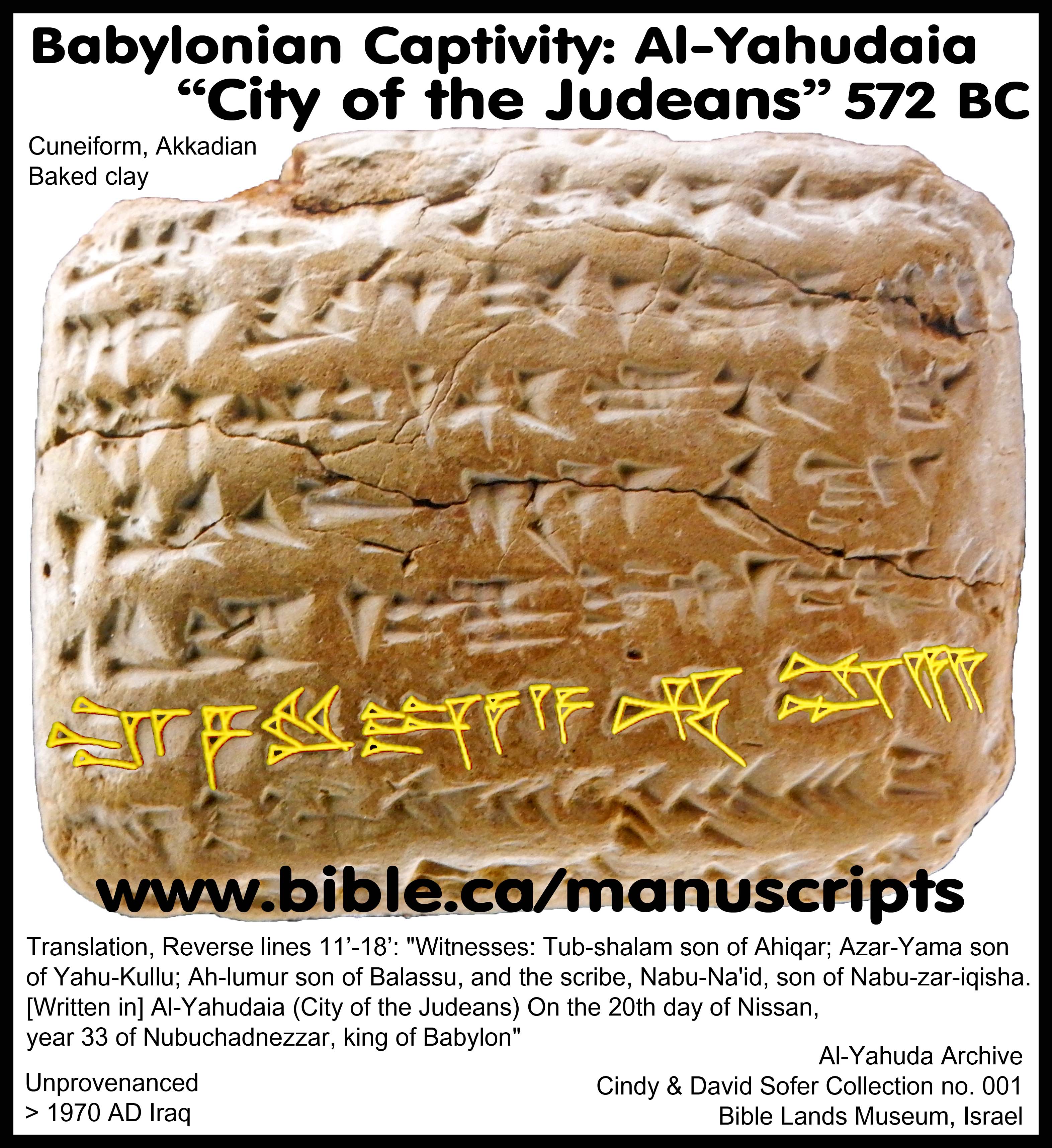
7. The Persian period 536-333 BC is where Aramaic became a dominant standard language throughout the world and Judea. Then with the arrival of Alexander the Great, Greek replaced Aramaic
8. In Judea, where Hebrew was extinct (except the high priests), Aramaic continued to be the “default language” down to the time of Christ and the first Jewish war and Masada.
a. Jesus’ cry “My God why have you forsaken me” was in Aramaic.
b. The Masada suicide ostraca lots were in Aramaic.
9. Strangely, the Aramaic alphabet was derived from the Hebrew alphabet they replaced! "Aramaic Hebrew" which spells words out in the Aramaic alphabet script.
10. "Aramaic Hebrew" was used by the by the Essenes in the Dead Sea Isaiah Scroll 150 BC, Jesus 30 AD.
11. We can prove Jesus used "Aramaic Hebrew" because "jots and tittles" do not exist in Paleo-Hebrew (Paleo-Hebrew)
a. “For truly I say to you, until heaven and earth pass away, not the smallest letter (Aramaic iota/yod) or stroke (tittle) shall pass from the Law until all is accomplished." (Matthew 5:18)
b.
Jots and tittles are different from the "dots and
dashes" seen in modern Hebrew.
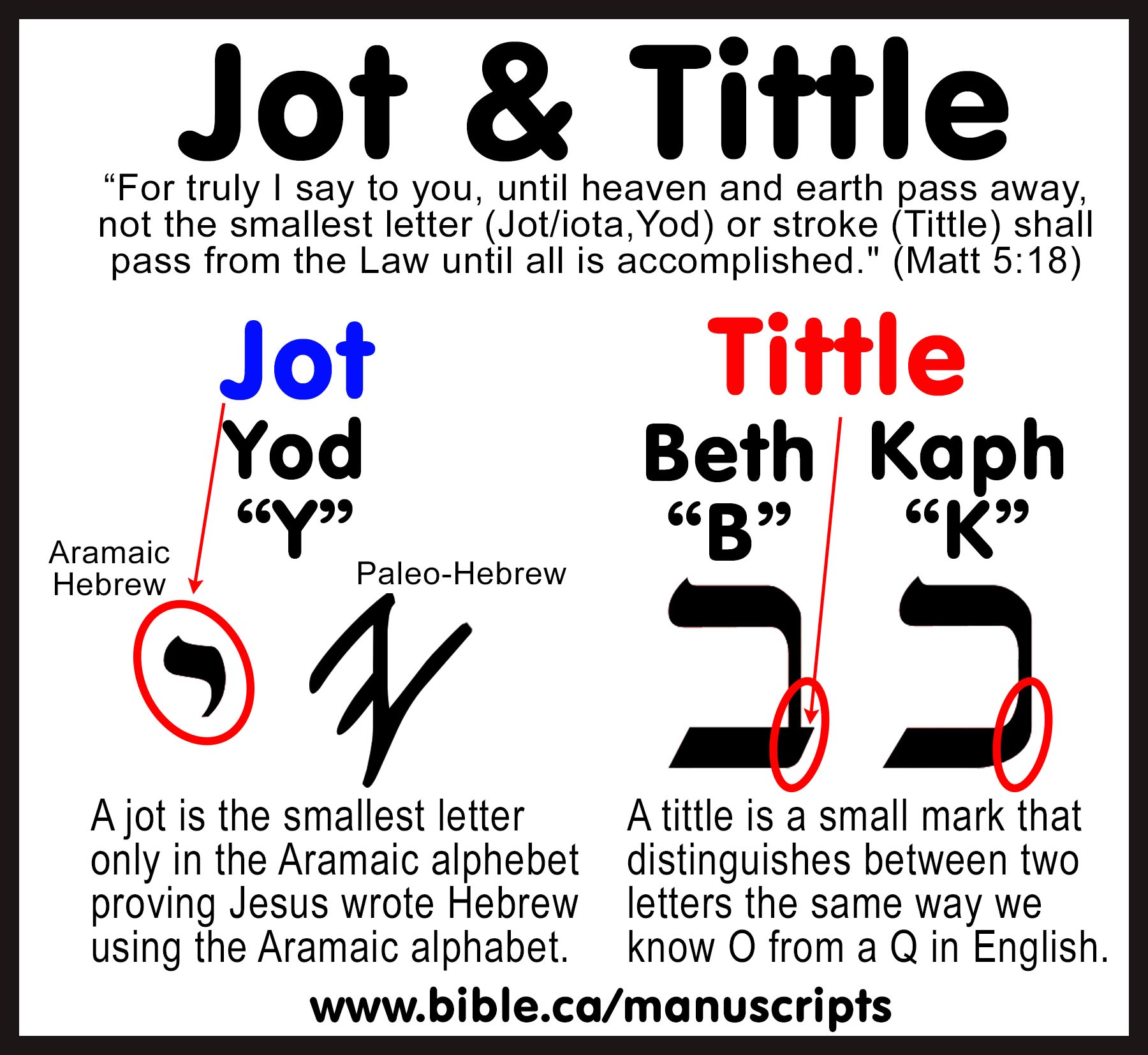
D. HEBREW SCRIPT #4: "Masoretic Hebrew", Vowelled Hebrew (600-1000 AD, 1915 + AD)
1. In the simplest terms "Masoretic Hebrew" is "Aramaic Hebrew with vowels".
a. For the entire period of the Bible none of the scripts uses by God’s people had any vowels.
b. Remember that Hebrew was a consonantal alphabet, which unlike English’s “A E I O U Y”, had no actual vowels.
c. Until the Masoretes invented a system of dots and dashes, it was impossible to know how to pronounce any Hebrew words.
2. The Masoretic Text (MT) is the oldest Hebrew manuscript of the Old Testament on earth and underlies most Bibles today.
a. Also known as "Codex Leningrad" the MT dates to 1008 AD.
b.
the Masoretes (600-950 AD) who copied the oldest
complete extant manuscript of the Hebrew Old Testament in 1008 AD (Codex
Leningrad, Masoretic Text) and modern Jews in Israel today (since 1915 AD).
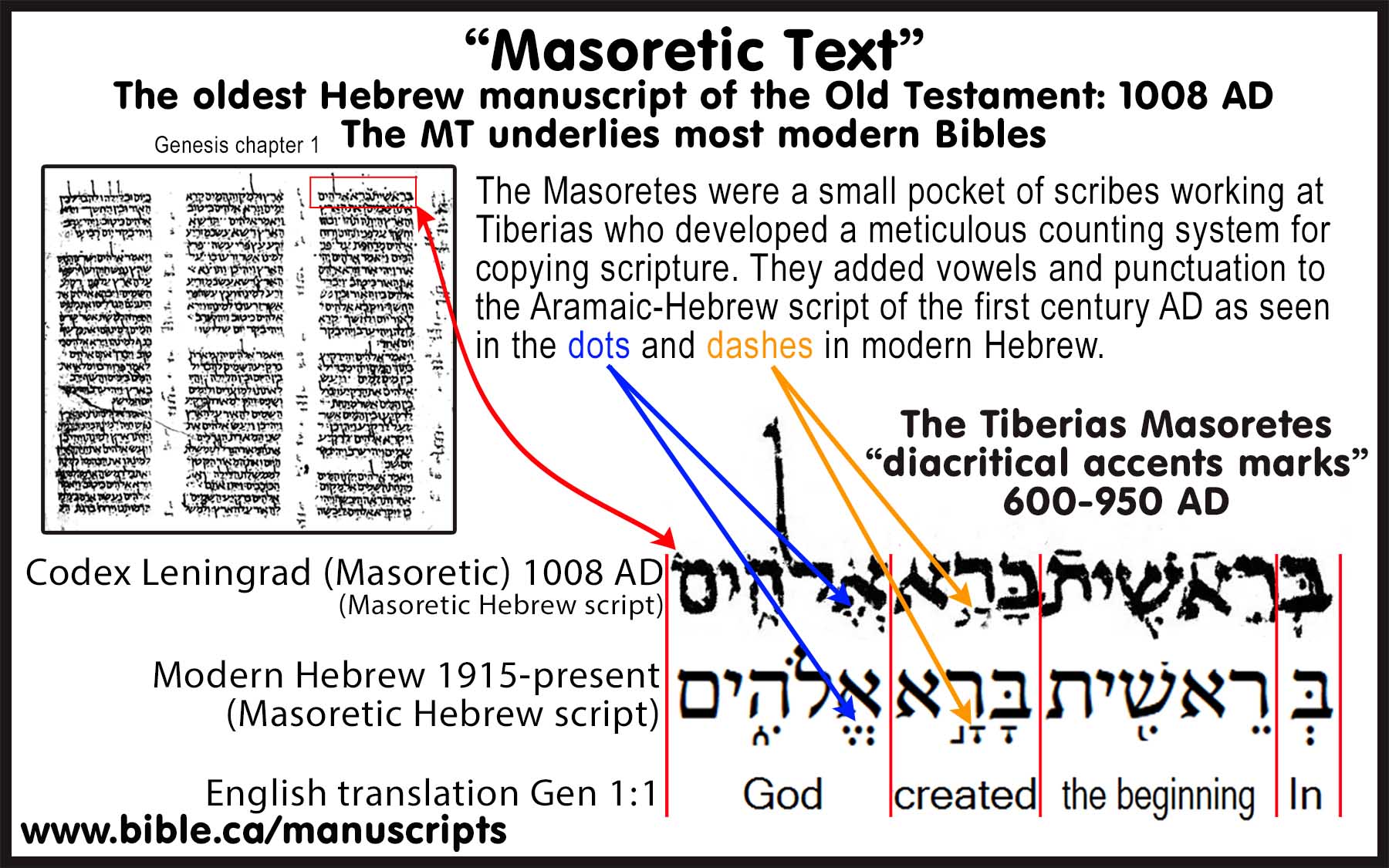
3. Starting in 600 AD the "Tiberian Masoretes" were an isolated "monk-like" sect of Jewish scribes living at Tiberius on the western shore of the sea of Galilee.
a. It was at Tiberius the Masoretes invented the system of the little dots and dashes that we see in modern Hebrew today and added them to "Aramaic Hebrew" which created a standardized vocalization of the spoken language in script.
b. These diacritical accents marks provide vowel pointing, punctuation and force interpretive choices between one of up to three possible options in "Aramaic Hebrew".
c. The Masoretes, who lived at Tiberius added spaces between some words and ornamentalized the "Aramaic Hebrew" to make it easier to read. The Masoretic system of dots and dashes did not exist in the first century. They also did not exist in "Paleo-Hebrew" when Moses wrote the autograph copies of the first five books of the bible which employed an entirely different alphabet.
4. "All this is not to suggest that the scribes and the Masoretes were infallible either in their pointing or in their understanding. They were not. At times the meaning may indeed have been lost, and the pointing consequently innovated." (The Current Quest for the Meaning of the Text of the Old Testament, Thomas A. Nicholas, Westminster Theological Journal, v34, p128, 1971 AD)
5. Modern restoration of Hebrew: 1915 - present:
a. The transformation of a living population to restore the long dead (2000 years) Hebrew language is unique in earth history.
c. It all began when "The father of Modern Hebrew" Eliezer Ben-Yehuda (1858-1922) moved to Israel in 1881 AD.
i. As a university educated historian that was fluent in Masoretic Hebrew, his first contribution was to write a foundational "Hebrew Lexicon".
ii. In 1900 AD the Hebrew population spoke Yiddish (German with Aramaic alphabet), Karaim (a Turkish like language with Aramaic alphabet), Ladino (Spanish language with Aramaic Alphabet)
iii. After 20 years of fruitless efforts to restore Hebrew to the population (only 10 families agreed to be "Hebrew only") he began a strong push for all the Jews living in Tel Aviv (founded in 1909 AD) to speak a restored "Masoretic Hebrew" by introducing it as the base language of schools.
iv. The "Hebrew Language Council" was formed in order to add modern non-Hebrew words like pink, elevator, cancer, microbe, umbrella, flirt etc.
d. Today the majority of the 6 million Jews living in modern Israel (total population 8.5 million) speak "Masoretic Hebrew".
e. A key point is to realize that we have no Manuscripts of the Old Testament in the original Hebrew alphabet known as "paleo-Hebrew" have ever been found. The first five books of Moses, Genesis, Exodus, Leviticus, Numbers and Deuteronomy were not penned in the same script as the Hebrew Masoretic Text (MT) which is used in our modern English Bibles. This is not a problem since we can easily prove that our Bible text is essentially unchanged over 2600 years.
Conclusion:
1. It should not surprise us that the first alphabet on earth was invented by God’s chosen people at the hands of Joseph when he entered Egypt.
a. Just as first Hebrew alphabet prepared the way for the written law of Moses, so too the translating the 39 books of the Hebrew old testament into Greek (Septuagint Tanakh) prepared the way for the Gospel of Christ to a world who spoke Greek.
b. We see God’s providence all down through history everywhere.
2. Four Hebrew Scripts: We see therefore, that the Hebrews have had four different written alphabet scripts:
a. Mosaic-Hieroglyphic Hebrew: 1859-1050 BC
b. Paleo-Hebrew: 1050 – 458 BC
c. Aramaic Hebrew (Square Hebrew): 458 – 70 AD
d. Masoretic Hebrew (Vowelled, modern) 600-1000; 1915-present.
3. Date of Script changes and the person who made the changes:
a. Mosaic-Hieroglyphic Hebrew script by invented by Joseph in 1859 BC.
b. Paleo-Hebrew script standardized by Samuel in 1050 BC
c. Aramaic-Hebrew “square” script adopted by Ezra in 458 BC.
d. Masoretic-Hebrew “vowelled” script invented by Masoretes in 600 AD.
4. See full outline on Samuel’s and Ezra’s script changes in the bible manuscripts
|
The Septuagint LXX “Scripture Cannot Be Broken” |
|||||
|
Start Here: Master Introduction and Index |
|||||
|
Six Bible Manuscripts |
|||||
|
1446 BC Sinai Text (ST) |
1050 BC Samuel’s Text (SNT) |
623 BC Samaritan (SP) |
458 BC Ezra’s Text (XIV) |
282 BC Septuagint (LXX) |
160 AD Masoretic (MT) |
|
Research Tools |
|||||
|
Steve Rudd, November 2017 AD: Contact the author for comments, input or corrections |
|||||
By Steve Rudd: November 2017: Contact the author for comments, input or corrections.
Go to: Main Bible Manuscripts Page
